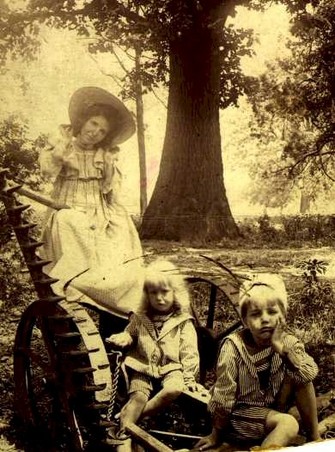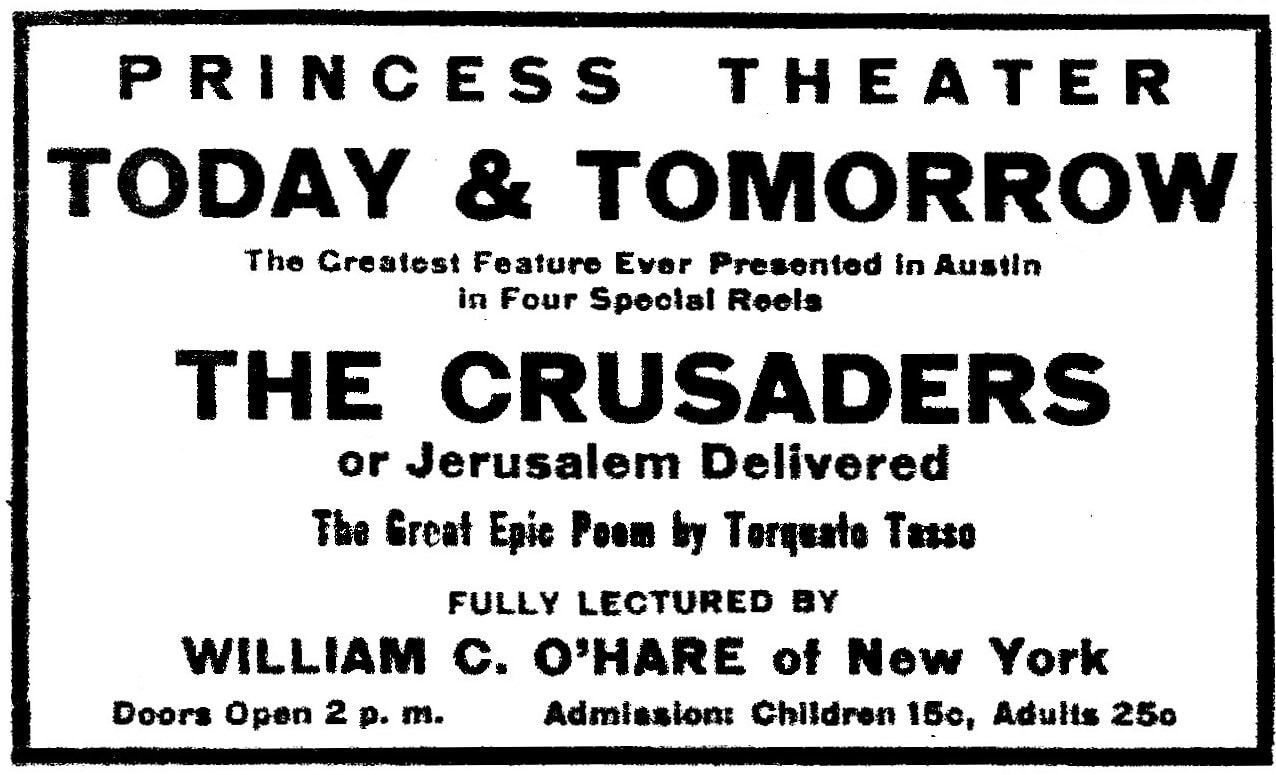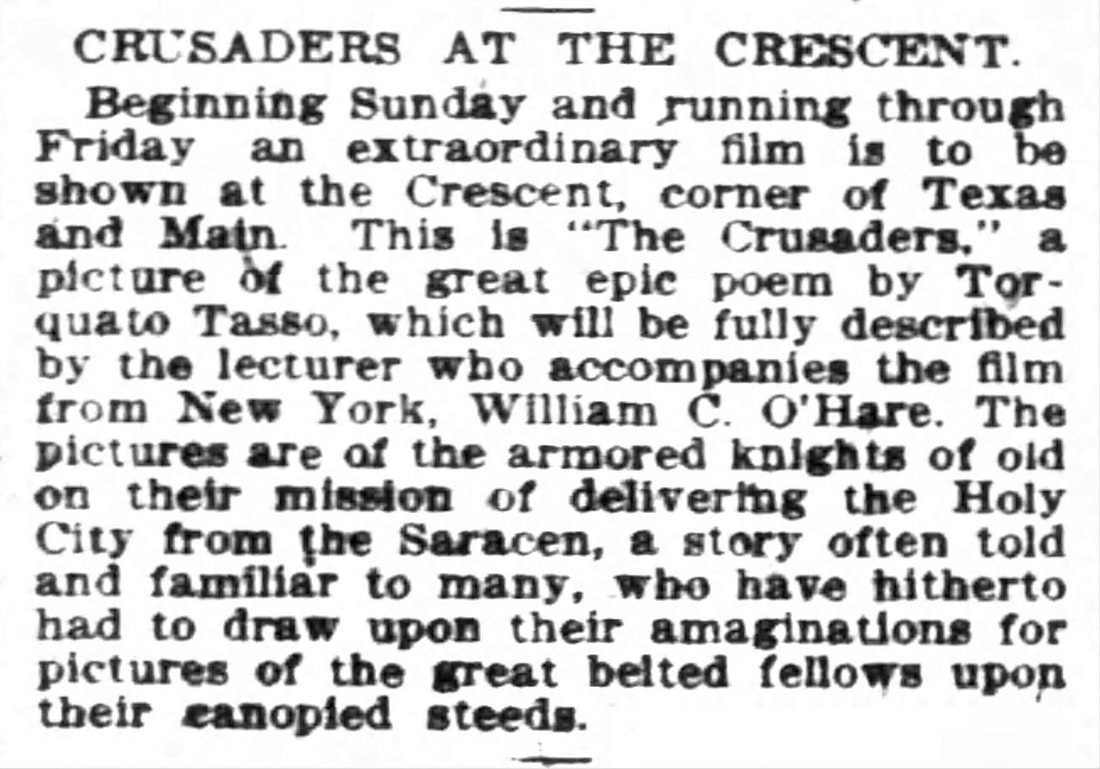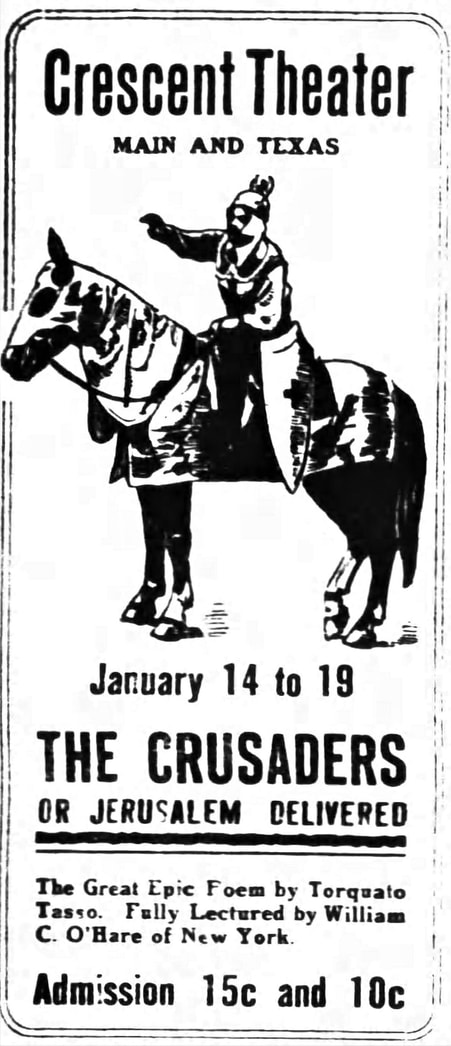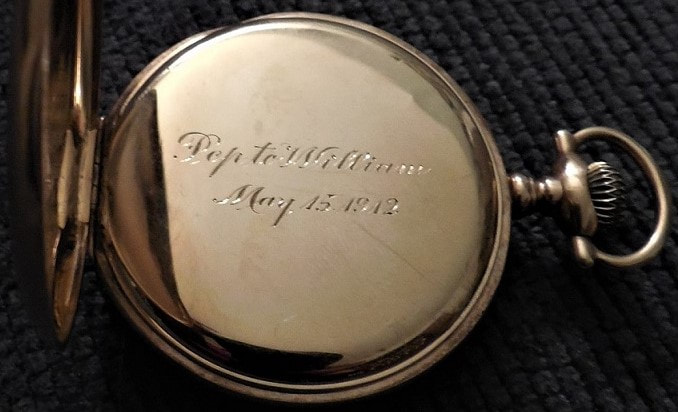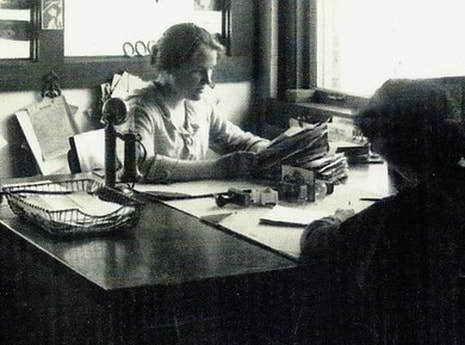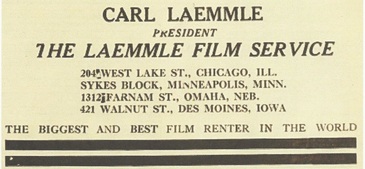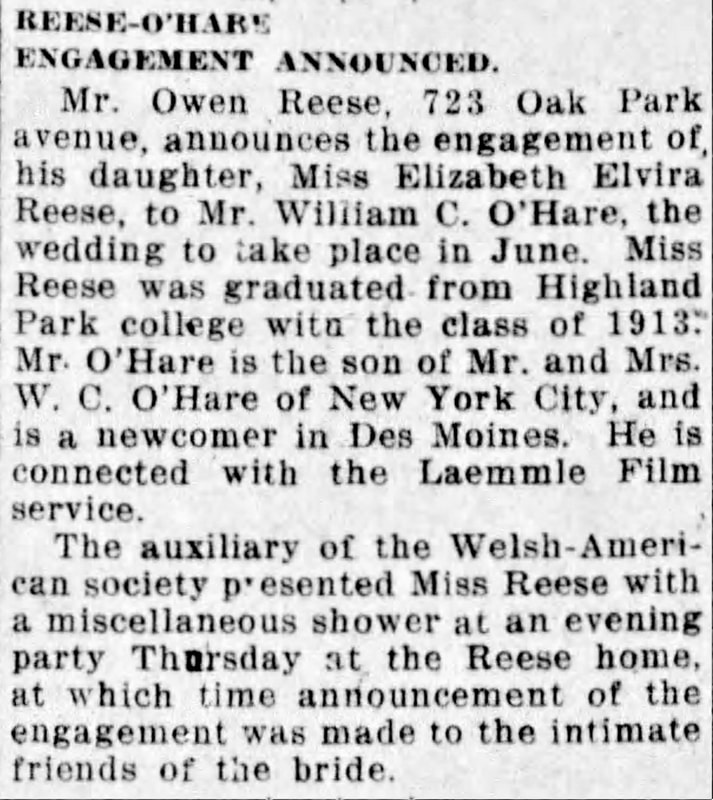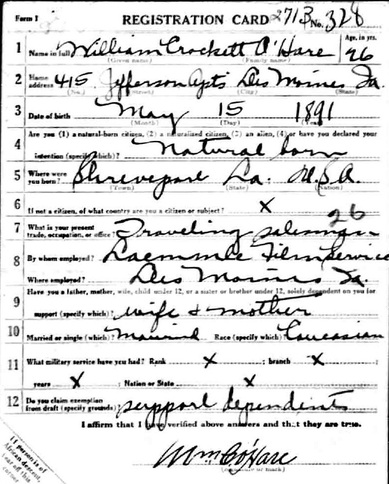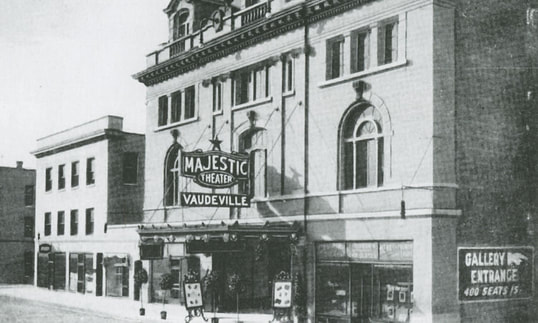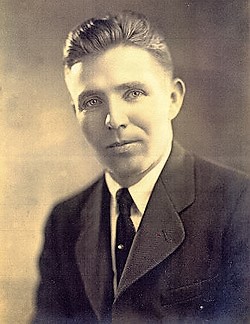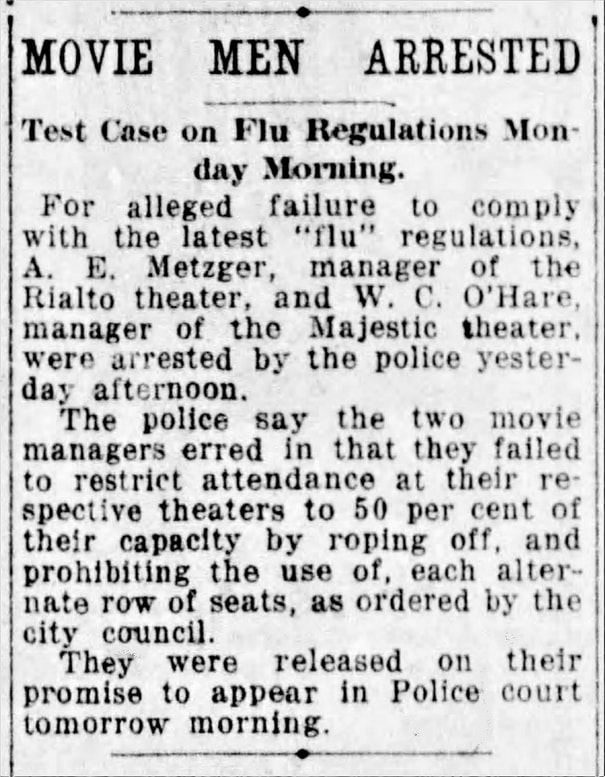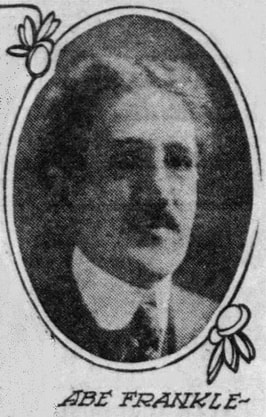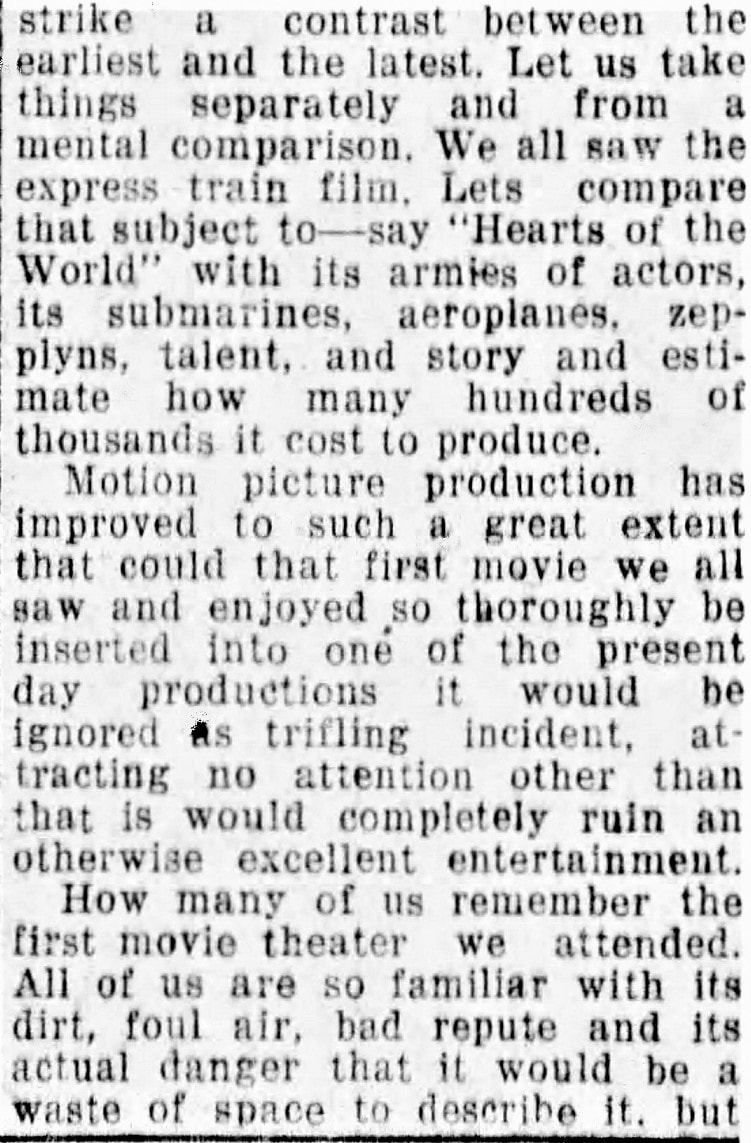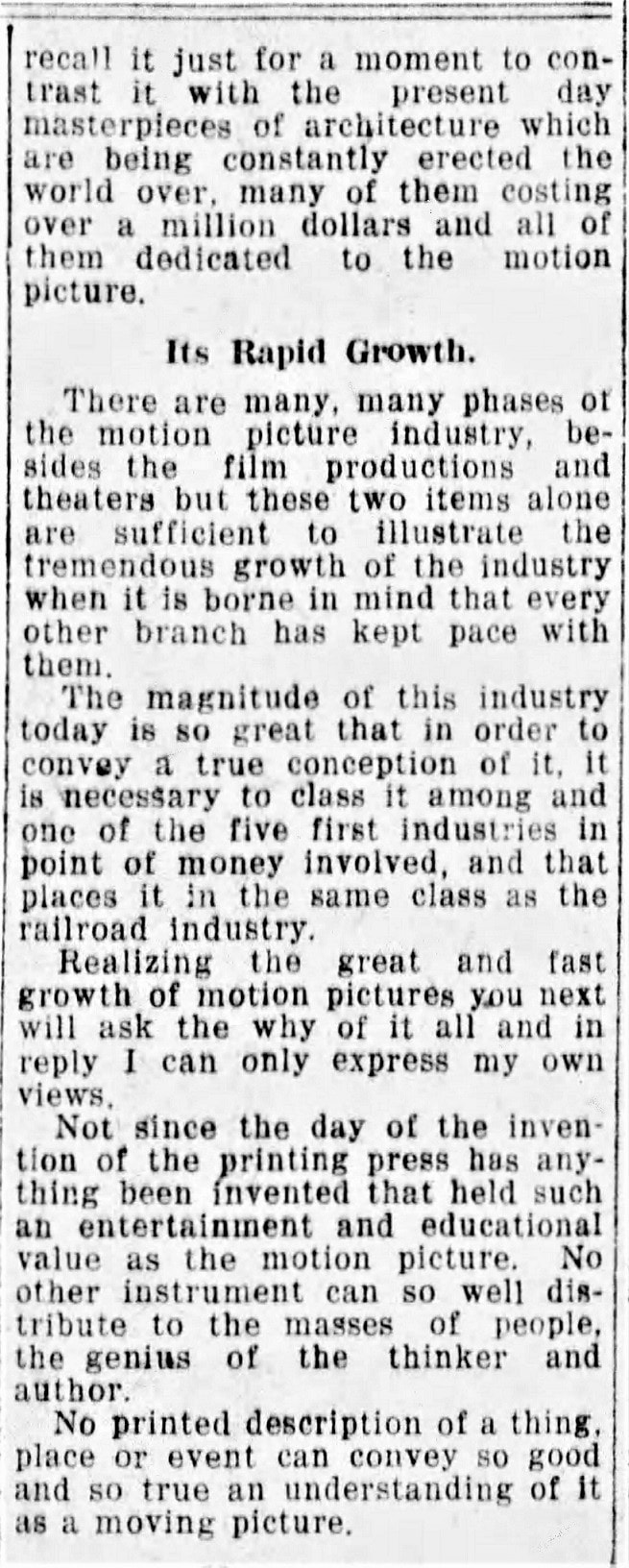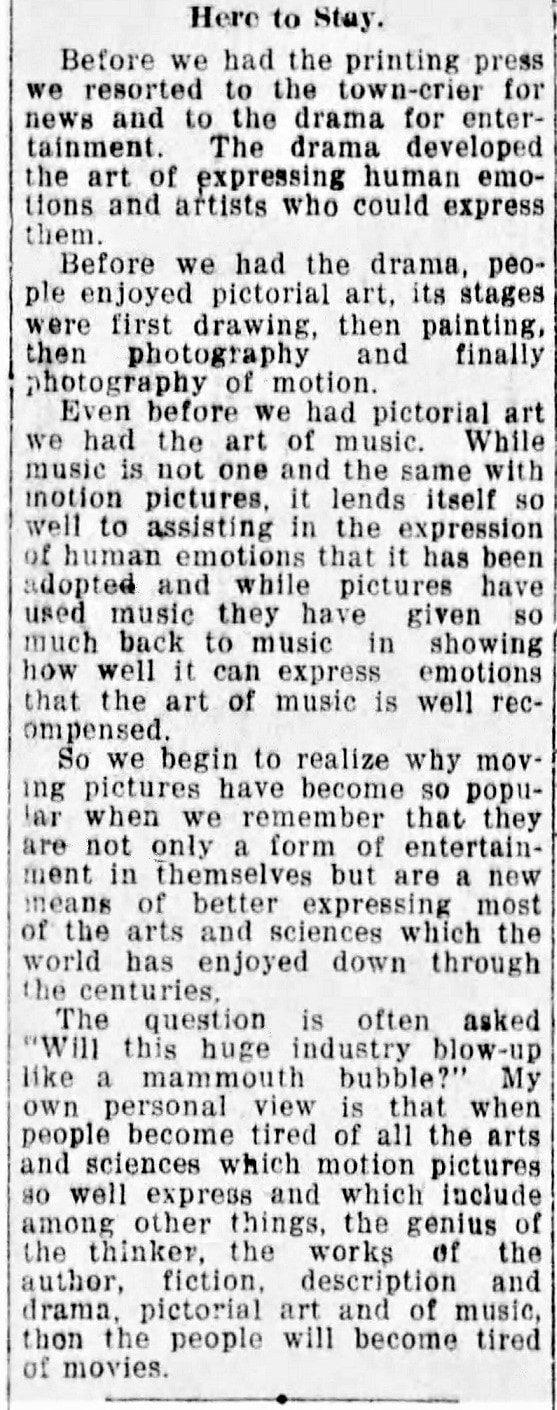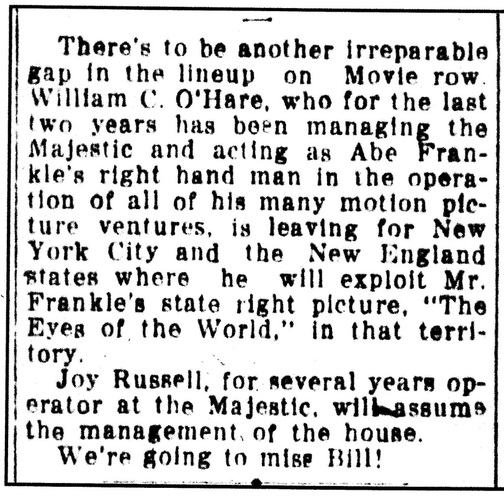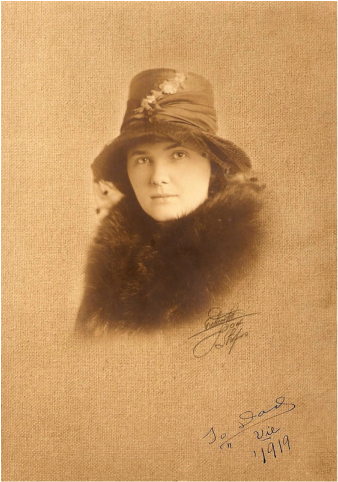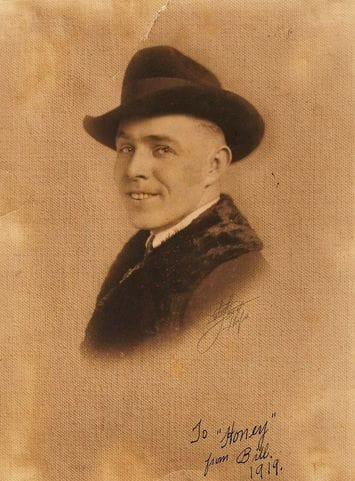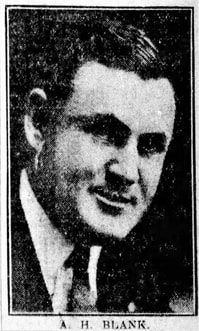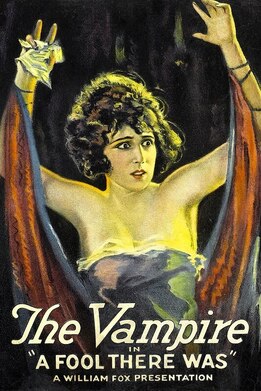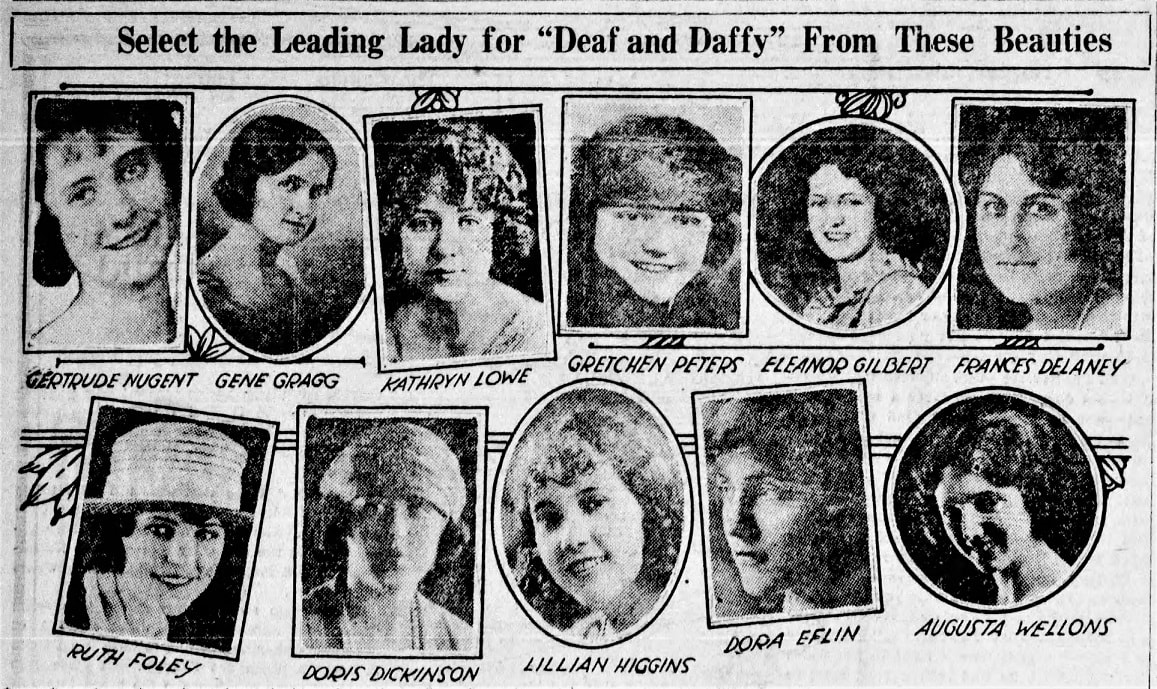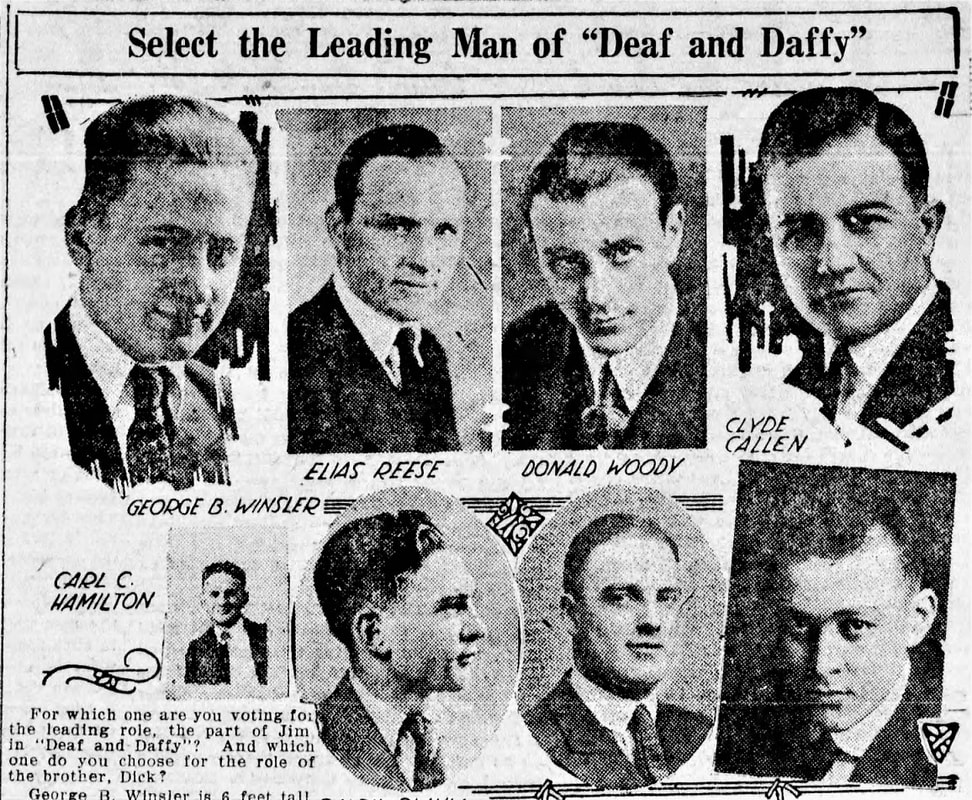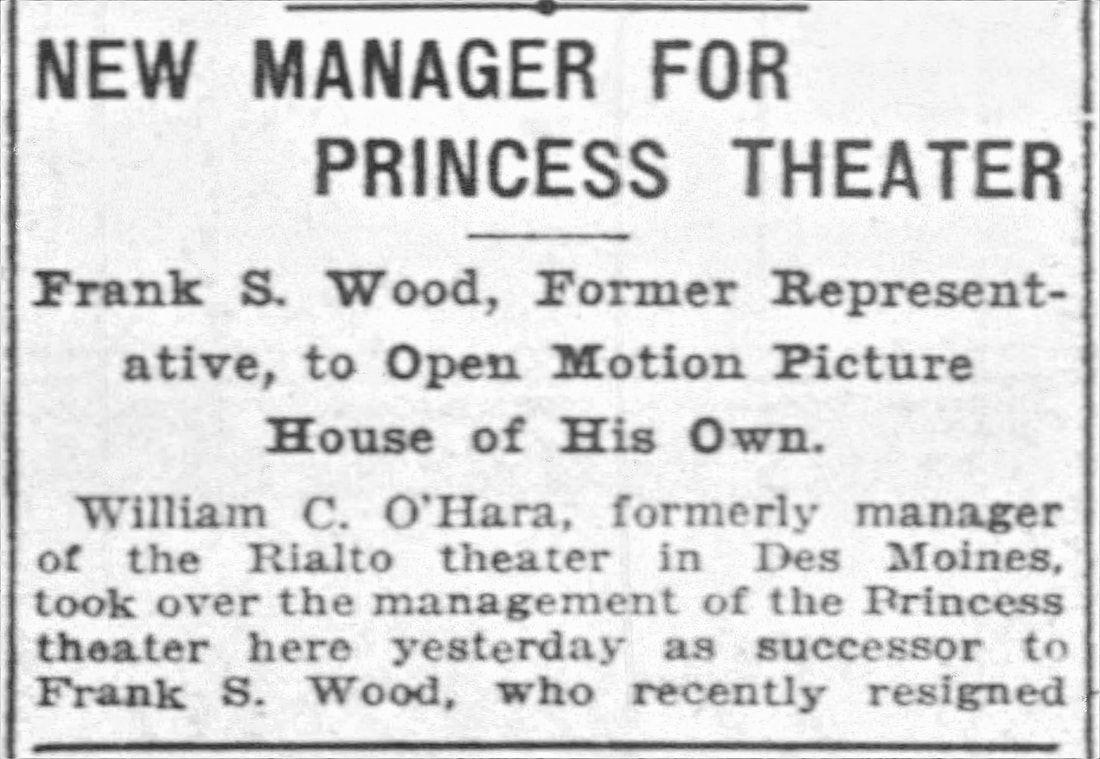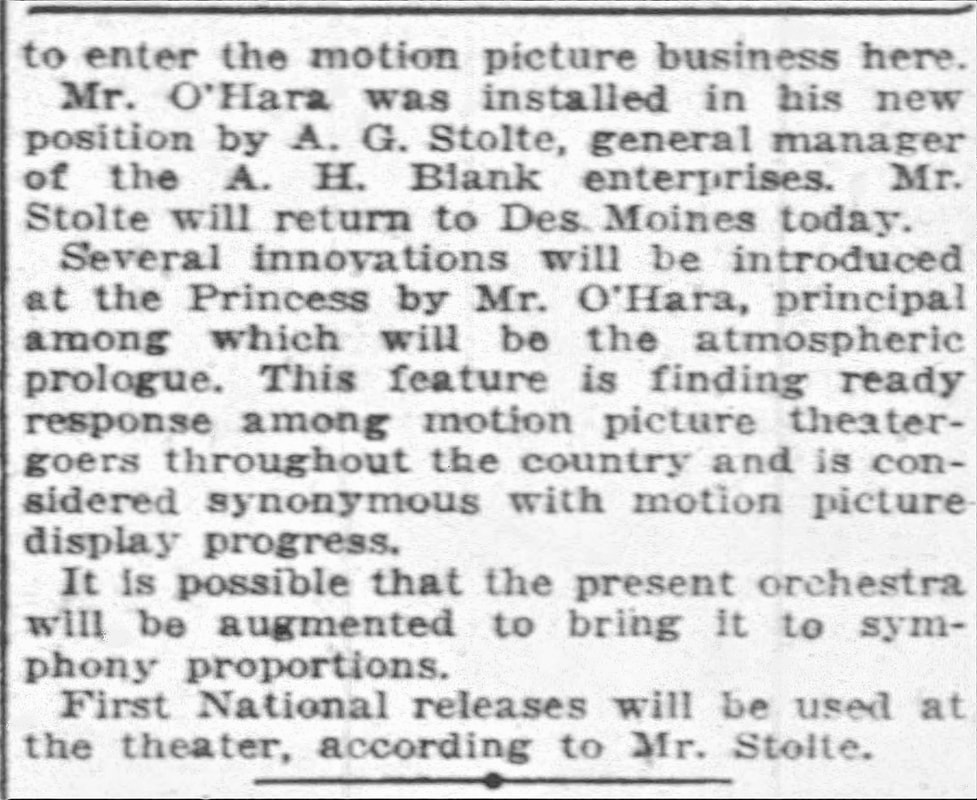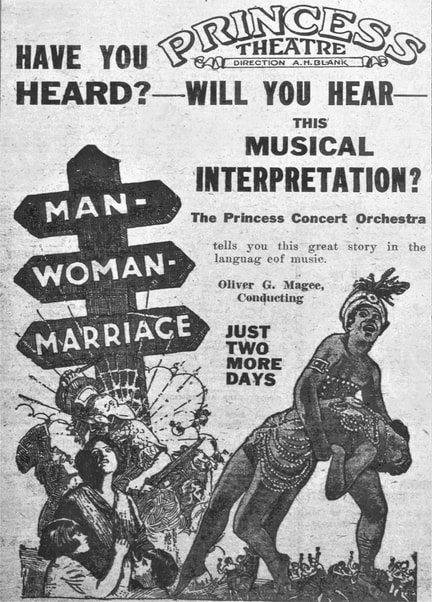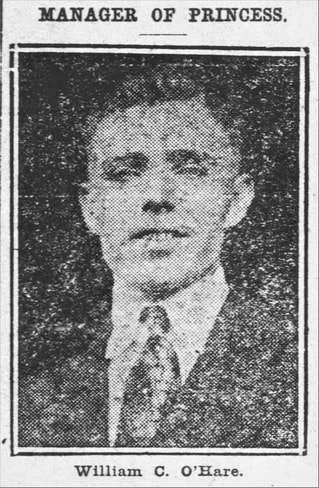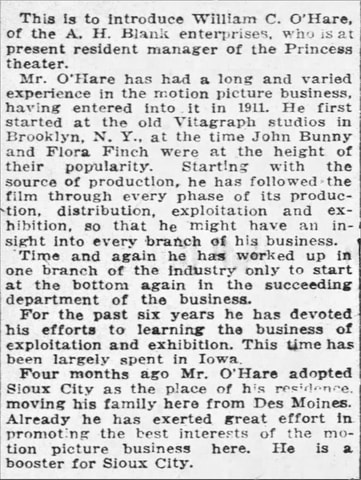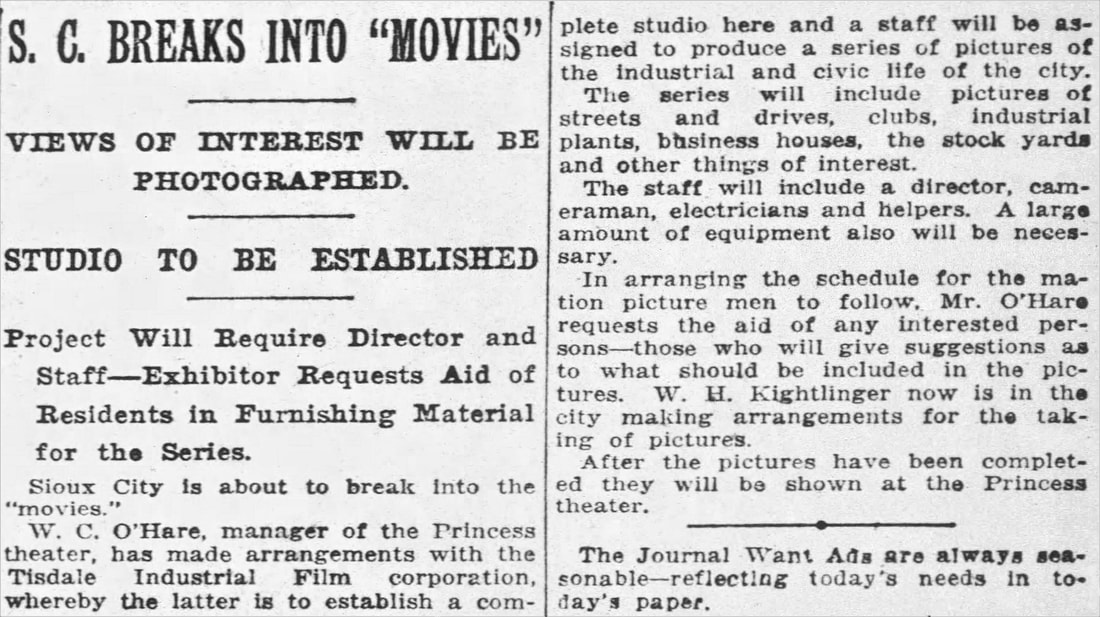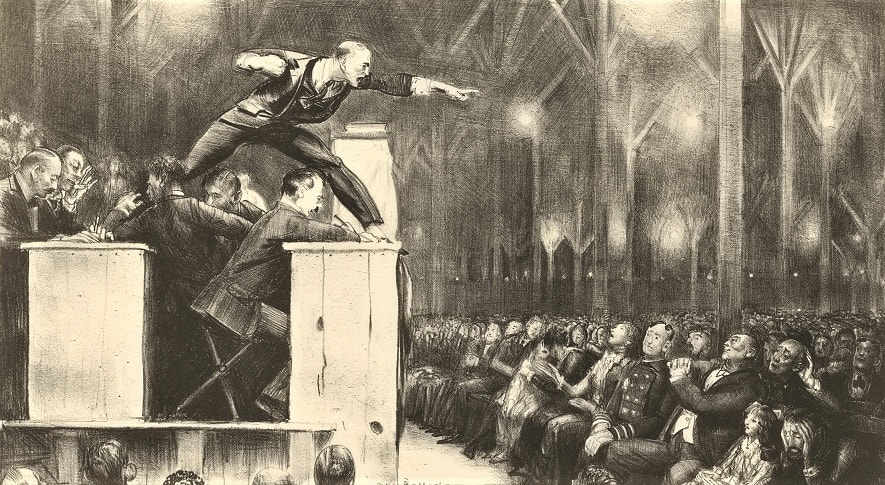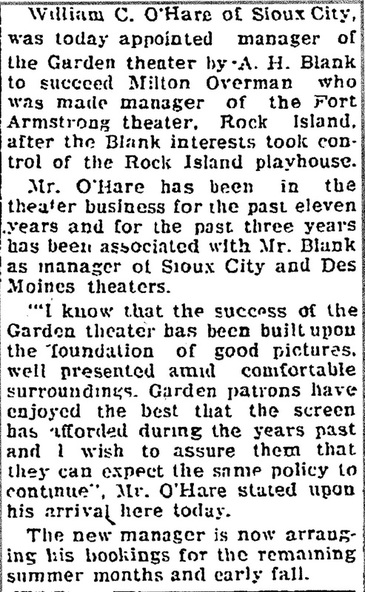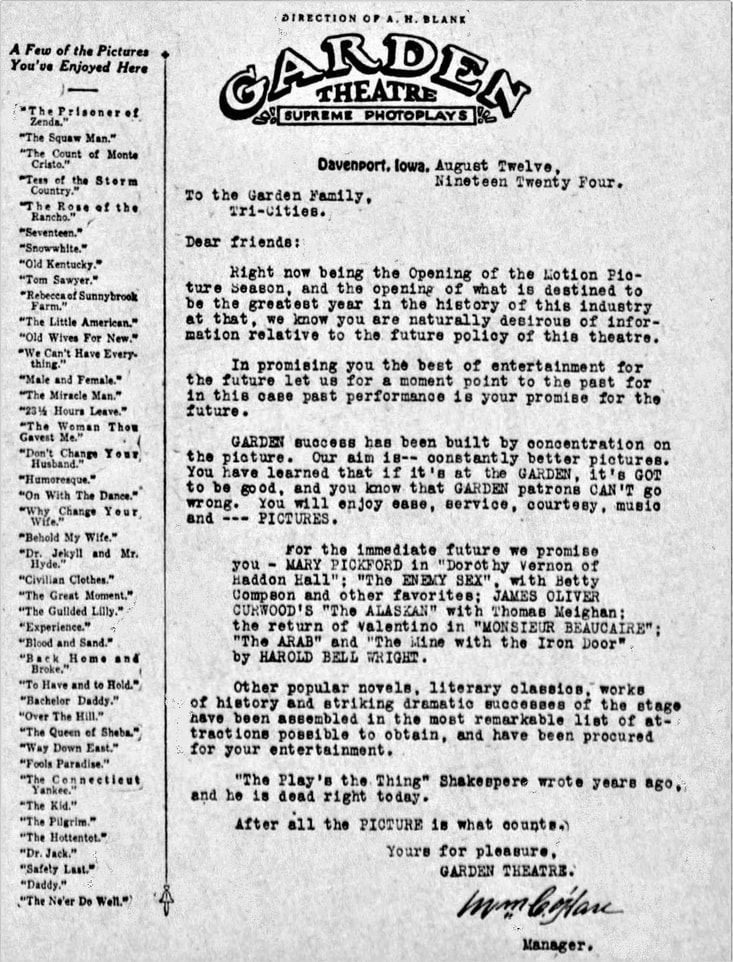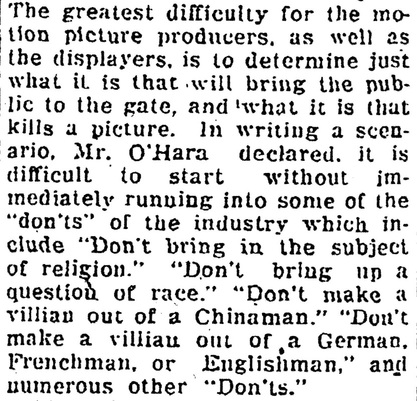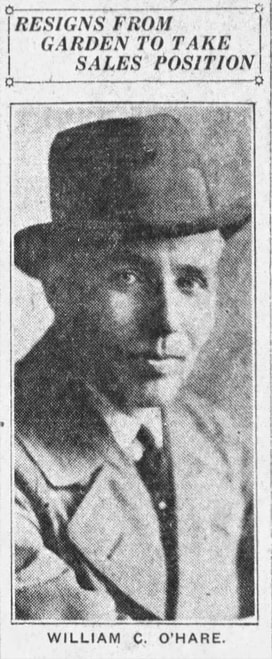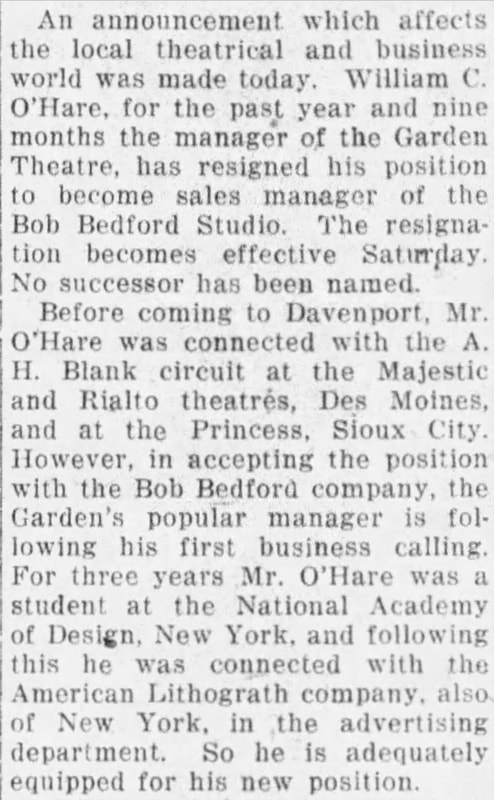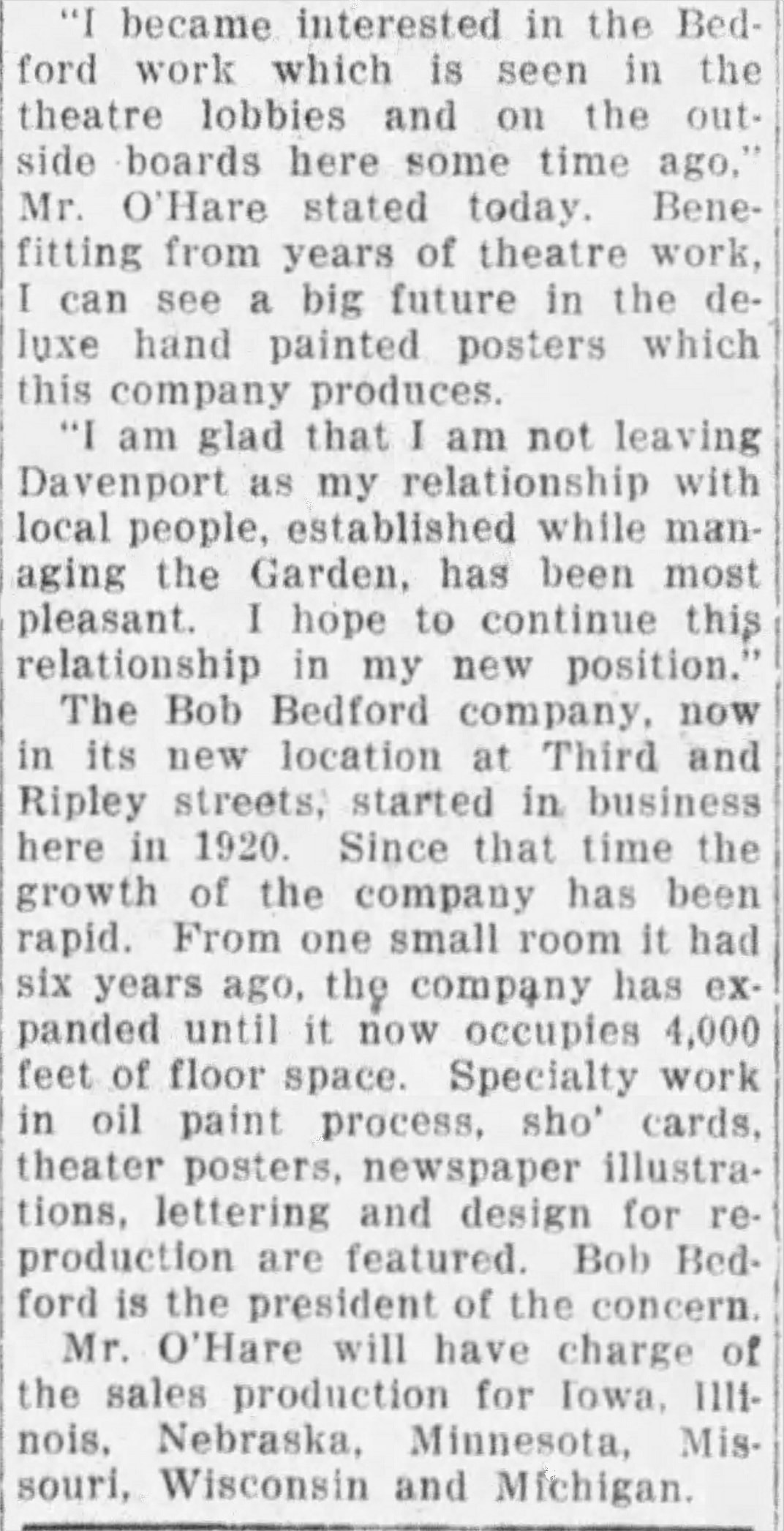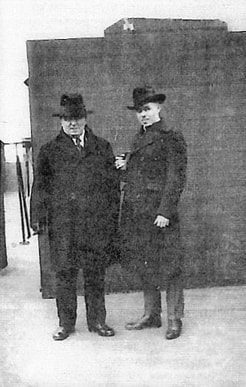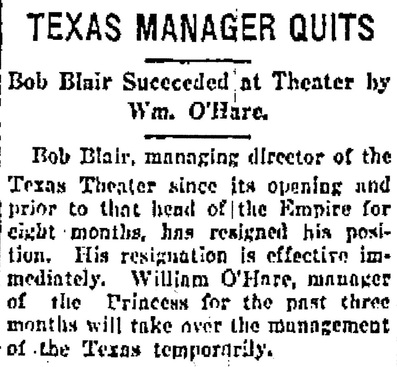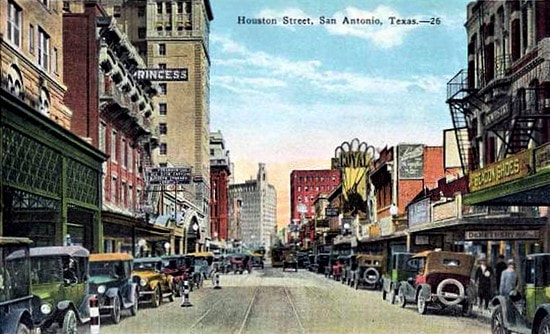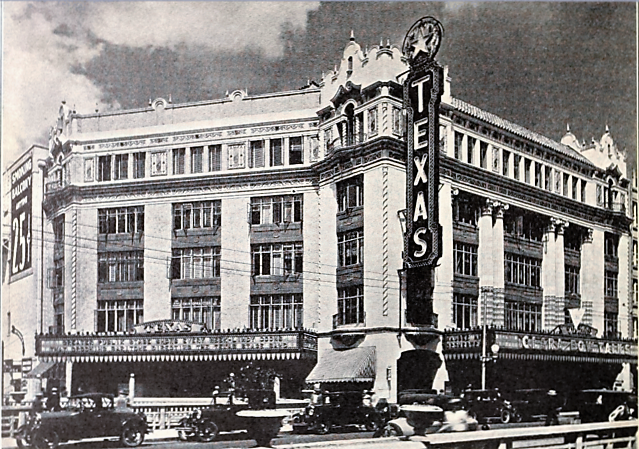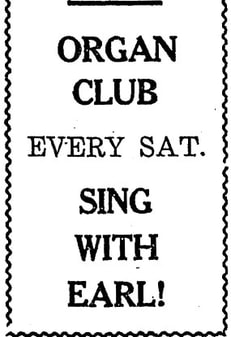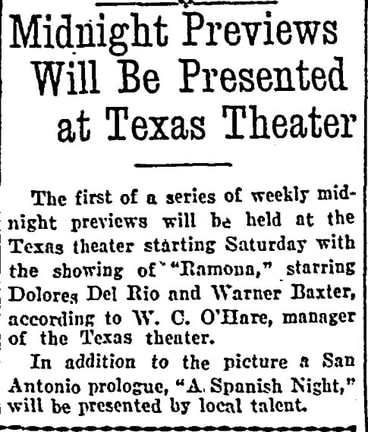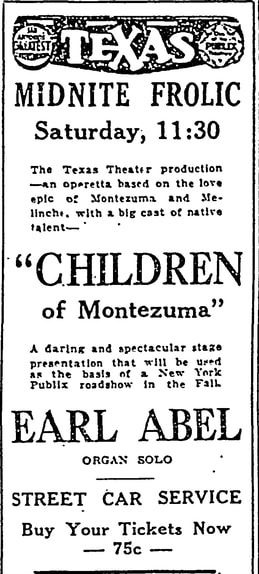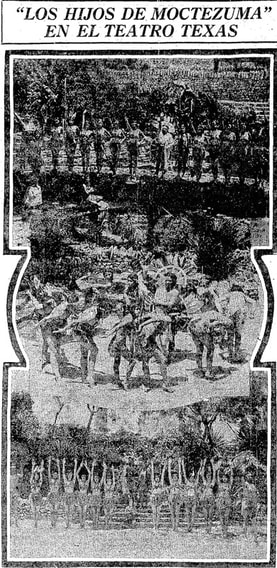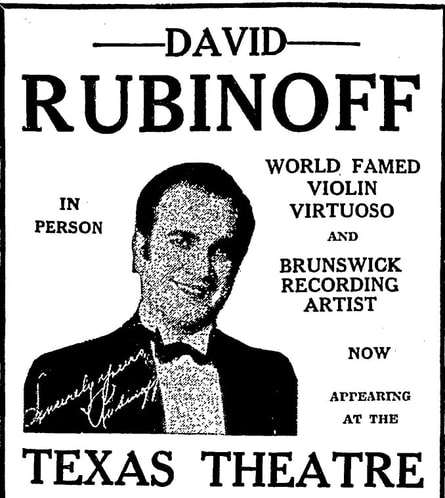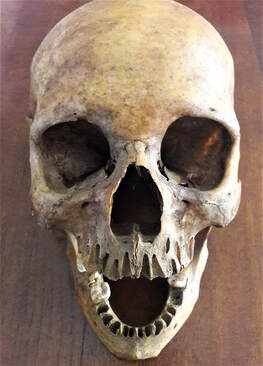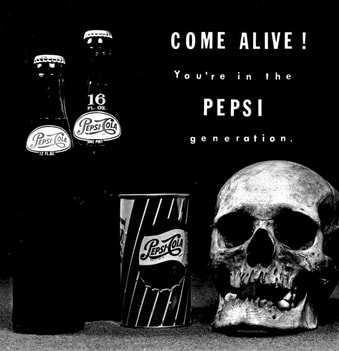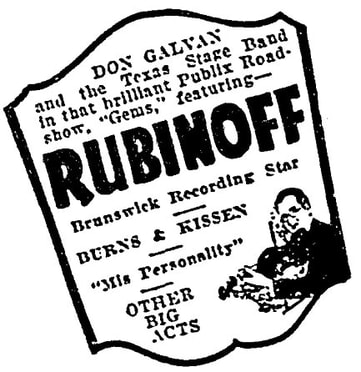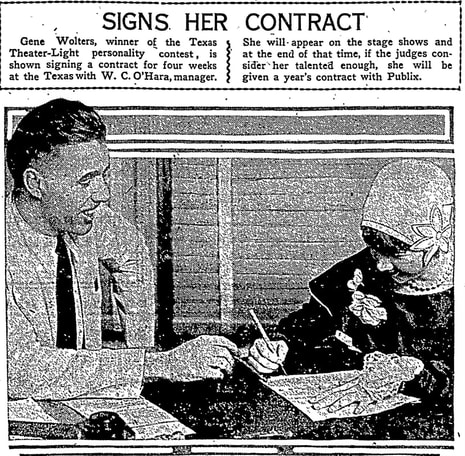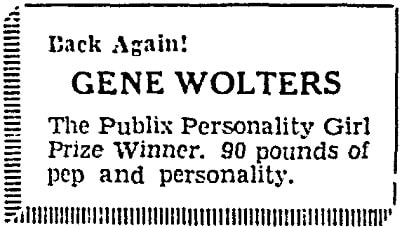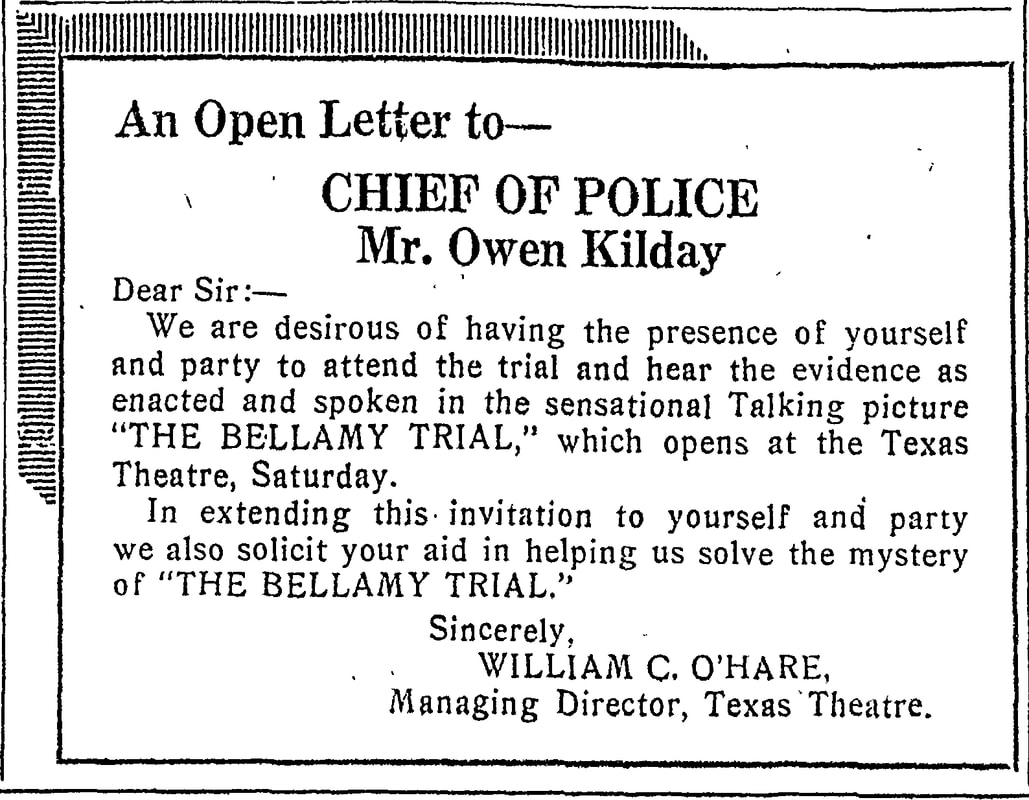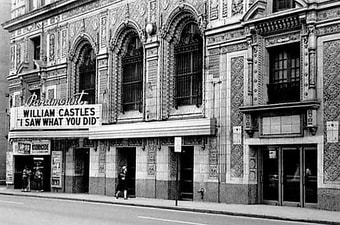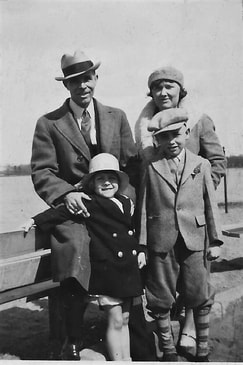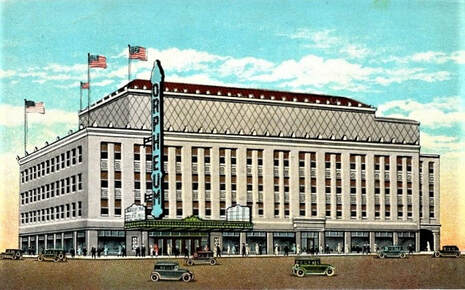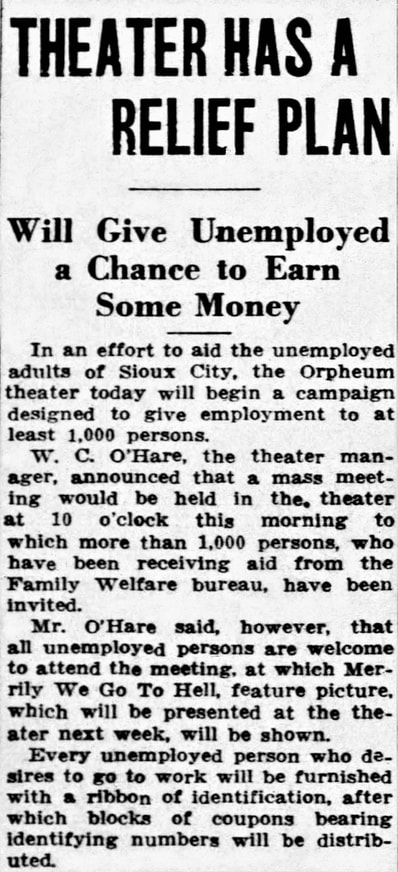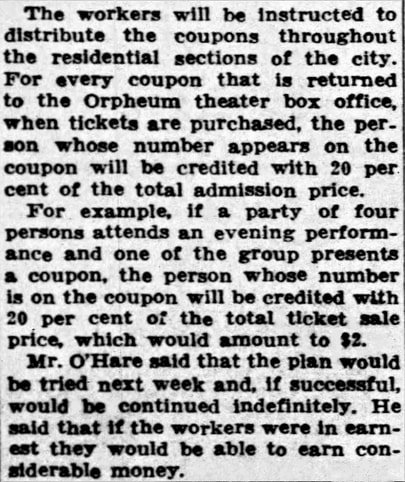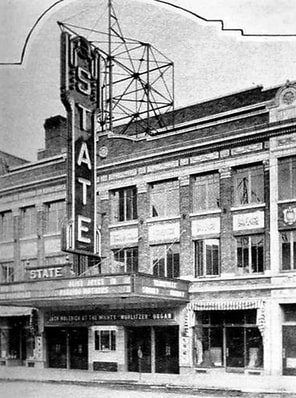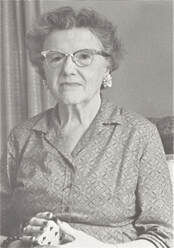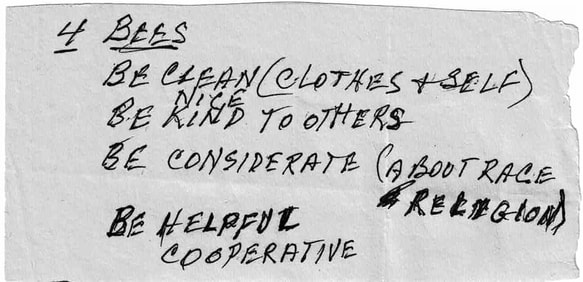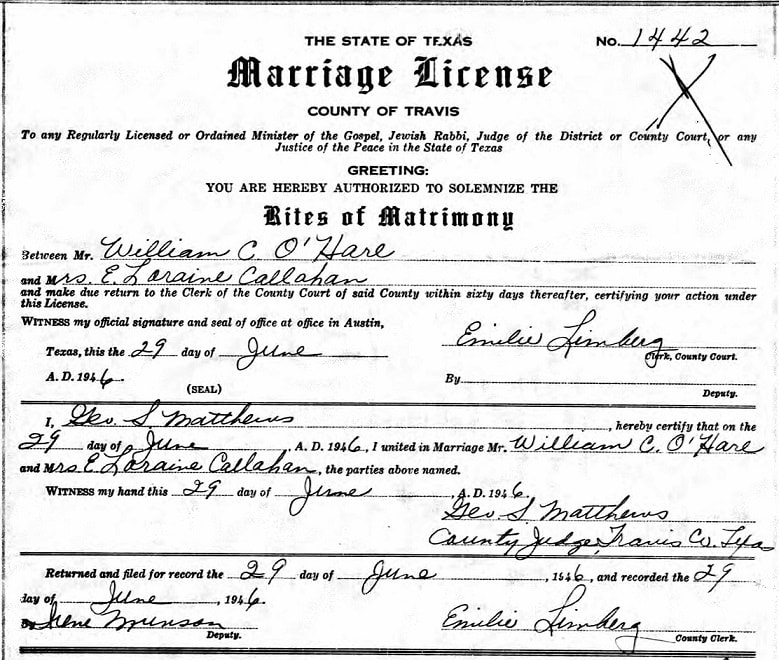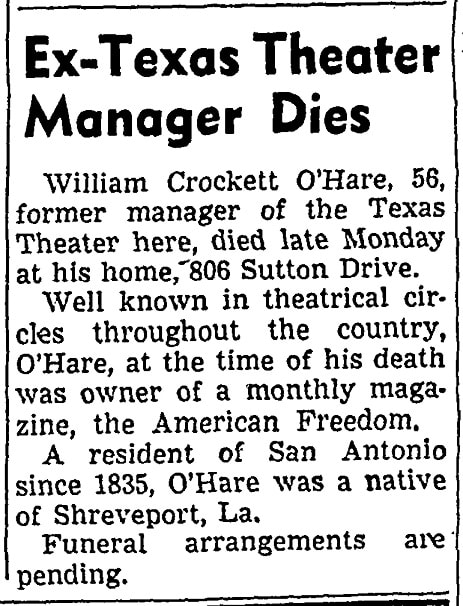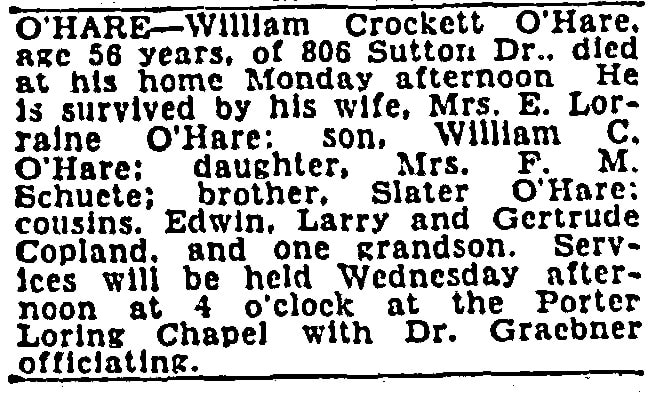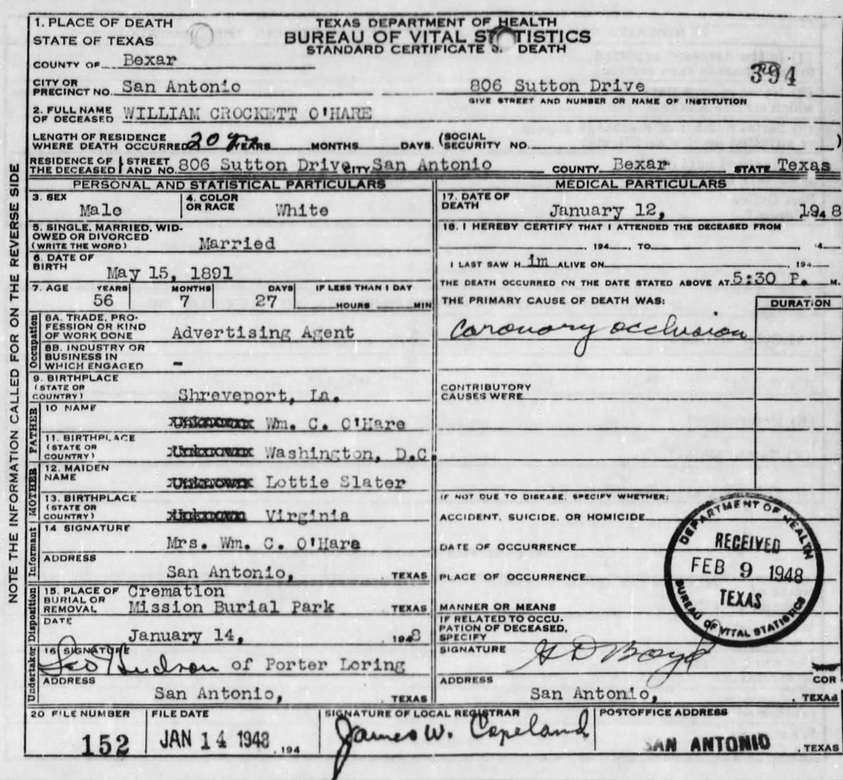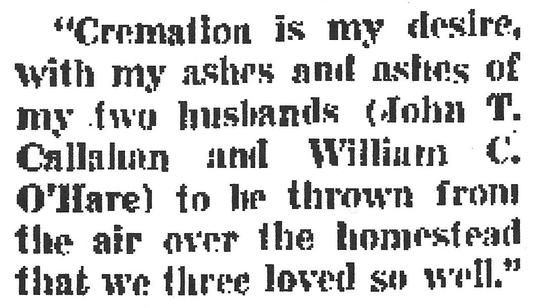Birth, Baptism Records, Early Childhood
Shreveport Birth Registry, 1891
W. C. O'Hare Jr. W [white] M [male] Date of birth: 5-15, 7 a.m. Father: W. C. O'Hare, Mother Lottie O'Hare, birthplaces: Washington DC and Tenn. Father's age 24. Father's occupation: Musician. Mother's age: 22. Mother's occupation: Housewife. Address: Shreveport, La. Physician: E. G. Allen Sacramental Records, Holy Trinity, Shreveport, LA, Archives of the Diocese of Shreveport
On June 7, 1891, Father Gentille, priest at Holy Trinity Catholic Church, baptized William Christopher and Lottie O'Hare's first son, William Crockett.
|
Sponsors George A. O'Hare and Catherine Copeland were William Christopher O'Hare's father and one of Lottie Slater O'Hare's older sisters, Mary Catherine "Kate" Slater Copeland, both apparently unable to attend. Proxy Jules Dubos was a local grocer; both Dubos' wife and proxy Fannie Ames sang in the Holy Trinity choir directed by O'Hare.
Early Years
William Crockett traveled frequently for a child of his time, making extended stays with his mother or shorter stays with both parents in such places as Marshall and Galveston (TX), Canada, New York, and Washington, D.C.
Other than documenting travel, only one Shreveport newspaper item has been found describing a childhood event--William Crockett's sixth birthday party:
Other than documenting travel, only one Shreveport newspaper item has been found describing a childhood event--William Crockett's sixth birthday party:
Just a week ago, yesterday, William O'Hare, Jr., was the happiest child in Shreveport, surrounded as he was by lovely children, who had come to his birthday party. . . . They all enjoyed sweet music and refreshments, which Prof. W. C. O'Hare and wife had generously prepared for them, and in all the games they were the very pictures of innocence and happiness.
By roughly age 10, he had moved to New York City with his family as William Christopher O'Hare began working for M. Witmark & Sons.
An April 1926 article, which will appear later on this page as a graphic, mentions that William Crockett spent three years as a student at the National Academy of Design in Manhattan. This information cannot be otherwise documented. Based on other life events, any classes at the National Academy of Design must have occurred during high school age, much like William Christopher's attendance at Spenserian Business College rather than a typical high school. The 1940 census indicates that William Crockett completed 8th grade, quite common for someone born in the late 19th century.
An April 1926 article, which will appear later on this page as a graphic, mentions that William Crockett spent three years as a student at the National Academy of Design in Manhattan. This information cannot be otherwise documented. Based on other life events, any classes at the National Academy of Design must have occurred during high school age, much like William Christopher's attendance at Spenserian Business College rather than a typical high school. The 1940 census indicates that William Crockett completed 8th grade, quite common for someone born in the late 19th century.
Career and Marriage
In 1910, William Crockett O'Hare, age 18-19, began working for Vitagraph in New York, performing miscellaneous tasks around the studios, eventually learning much about the film industry. A 1921 Des Moines Register article claimed he "had learned every detail of the business in every branch": developing and printing film, producing special films, distributing, and advertising.
In 1912, twenty-year-old O'Hare was on the road as a film lecturer, explaining and promoting The Crusaders, a silent film based on Tasso's epic poem about the 1099 siege of Jerusalem. |
The 1915 New York State Census indicates that William Crockett O'Hare (24) worked as a lithographer and lived with his mother Lottie, younger brother Slater (also a lithographer), and his sister-in-law. According to a later newspaper article, both brothers may have worked in the advertising department of the American Lithograph Company. At least, William Crockett reportedly did so.
Des Moines, Iowa
In 1915 or early 1916, William Crockett O'Hare moved to Des Moines where, in the spring of 1916, he became engaged to Elizabeth Elvira "Vie" Reese, the fourth of nine children of a Welsh immigrant mine supervisor and his wife, also from a Welsh mining family. O'Hare and his fiancée worked for Laemmle Film Services, he as a salesman and she as a correspondent.
William Crockett O'Hare and Vie Reese married on June 17, 1916, three weeks after their engagement was announced to her friends. Might this timing hint at an interesting family story? My dad, William Crockett's son, told me he had an older sister who was either stillborn or died soon after birth. He gave no other details and may not have known any. Without birth records, one cannot be sure of the reason for the rushed wedding.
Des Moines, Iowa
In 1915 or early 1916, William Crockett O'Hare moved to Des Moines where, in the spring of 1916, he became engaged to Elizabeth Elvira "Vie" Reese, the fourth of nine children of a Welsh immigrant mine supervisor and his wife, also from a Welsh mining family. O'Hare and his fiancée worked for Laemmle Film Services, he as a salesman and she as a correspondent.
William Crockett O'Hare and Vie Reese married on June 17, 1916, three weeks after their engagement was announced to her friends. Might this timing hint at an interesting family story? My dad, William Crockett's son, told me he had an older sister who was either stillborn or died soon after birth. He gave no other details and may not have known any. Without birth records, one cannot be sure of the reason for the rushed wedding.
According to William Crockett's World War I Draft Registration, his sales position at Laemmle involved travel, and he supported not only his wife, but also his mother Lottie.
By August 20, 1917, less than two months after O'Hare's draft registration, the Des Moines Evening Tribune spoke of his participation in the paper's "smokes for the soldiers" campaign by setting up a donation barrel in the theater lobby and by donating a percentage of ticket sales during busy Iowa State Fair week.
More important than the "smokes" campaign participation, however, the Evening Tribune also revealed he had left Laemmle at some point during the past two months to manage the Majestic Theater. The change from sales to management would have enabled him to stay in town and probably pleased his wife of little more than a year. He would remain at the Majestic, owned by Abe Frankle--a local entertainment entrepreneur--into 1919.
More important than the "smokes" campaign participation, however, the Evening Tribune also revealed he had left Laemmle at some point during the past two months to manage the Majestic Theater. The change from sales to management would have enabled him to stay in town and probably pleased his wife of little more than a year. He would remain at the Majestic, owned by Abe Frankle--a local entertainment entrepreneur--into 1919.
Trouble with the Law. While managing the Majestic, O'Hare ran afoul of the law. During the Spanish flu pandemic, he not only voiced his opposition to proposed local restrictions, but refused to follow the city council's soon established mandates.
On December 4, 1918, the city flu committee recommended that all theaters, moving picture houses, dance halls, public and private dances, skating rinks, and public schools and Sunday schools be immediately shut down for ten days and that colleges, 5 and 10 cent stores, department store bargain basements, churches, lodges, and pool and billiard halls be allowed to remain open only if all people inside wore masks.
The Des Moines Register has preserved William Crockett O'Hare's comments as representative of theater owners and managers: "If the theaters are closed, a general depression results. However, if the situation warrants such drastic action, we believe that no half way measures should be taken but that all assemblies and congregations should be dispensed with." In other words, the city should not require theaters to lock their doors while allowing many other gathering places to remain opened.
Theater managers conducted business as usual, pending the city council's December 5 meeting to consider the flu committee's recommendation.
After meeting with the flu committee, theater owners and managers, businessmen, labor unions, and citizens, the city council issued a decision it believed would "disturb to a minimum the normal course of business and amusement places generally accepted as essential to preserve the morale of the people." In short, the city council took a middle ground.
Effective 7:00 a.m, on Friday, December 6, Des Moines would enforce new restrictions. Dance halls, public and private dances, skating rinks, indoor athletics, public schools and Sunday schools would shut down for a minimum of ten days. "Special officers" would be assigned to the entrances of 5 and 10 cent stores to limit the number of shoppers at any given time. Theaters and moving picture houses would rope off alternating rows, thus limiting seating to half capacity.
On December 8, the Register announced O'Hare's and another manager's arrests:
On December 4, 1918, the city flu committee recommended that all theaters, moving picture houses, dance halls, public and private dances, skating rinks, and public schools and Sunday schools be immediately shut down for ten days and that colleges, 5 and 10 cent stores, department store bargain basements, churches, lodges, and pool and billiard halls be allowed to remain open only if all people inside wore masks.
The Des Moines Register has preserved William Crockett O'Hare's comments as representative of theater owners and managers: "If the theaters are closed, a general depression results. However, if the situation warrants such drastic action, we believe that no half way measures should be taken but that all assemblies and congregations should be dispensed with." In other words, the city should not require theaters to lock their doors while allowing many other gathering places to remain opened.
Theater managers conducted business as usual, pending the city council's December 5 meeting to consider the flu committee's recommendation.
After meeting with the flu committee, theater owners and managers, businessmen, labor unions, and citizens, the city council issued a decision it believed would "disturb to a minimum the normal course of business and amusement places generally accepted as essential to preserve the morale of the people." In short, the city council took a middle ground.
Effective 7:00 a.m, on Friday, December 6, Des Moines would enforce new restrictions. Dance halls, public and private dances, skating rinks, indoor athletics, public schools and Sunday schools would shut down for a minimum of ten days. "Special officers" would be assigned to the entrances of 5 and 10 cent stores to limit the number of shoppers at any given time. Theaters and moving picture houses would rope off alternating rows, thus limiting seating to half capacity.
On December 8, the Register announced O'Hare's and another manager's arrests:
On December 12, the Register reported, "A test of the legality of council as a board of health imposing restrictions upon attendance at theaters is presaged by the filing of informations in Police court this morning against three downtown theater managers." The manager of the Empress had been added to the accused offenders.
The three men had not yet been served with the charges; therefore, no hearing date had been scheduled. Because I could not locate further information in Des Moines papers, the city may have dropped the case or settled quietly out of court. Presumably, the three managers began complying with the mandate.
The three men had not yet been served with the charges; therefore, no hearing date had been scheduled. Because I could not locate further information in Des Moines papers, the city may have dropped the case or settled quietly out of court. Presumably, the three managers began complying with the mandate.
|
A Fight against Film Tax. A year later, in early 1919, a U. S. Senate conference committee and the House Ways and Means Committee were discussing levying a 5% tax on all film rentals. On January 29, the Des Moines Register published W. C. O'Hare's opinion as member of a local exhibitors' committee composed of theater owners A. H. Blank, Abe Frankle, and O'Hare, himself. As the committee circulated a petition among theater goers, O'Hare argued that the tax would force theaters to raise ticket prices or close forever. According to O'Hare, theaters were already paying nine taxes, and managers across the country were using any means they could to defeat an additional tax, "including newspaper space, film advertising, personal appeal, and petitions." The paper reported that theater people and ticket buyers were flooding congressional mailboxes with letters and telegrams.
By February 4, movie men across Iowa had united in opposition. The state organization's slate of officers included Abe Frankle as president and O'Hare as secretary. Although theater owners. managers, and theater goers nationwide fought the film tax, it went into effect on May 1. Theaters began announcing ticket price increases. |
Thoughts on the Changing Film Industry. On August 10, 1919, the Des Moines Register carried O'Hare's article on the evolution and future of the motion picture industry and its relation to the arts and sciences.
O'Hare must have seen the strip of film during a family visit to one of Lottie's sisters, who lived in Temple for several years.
On the Road Again. One week later, August 17, 1919, the Des Moines Register announced O'Hare would be leaving the Majestic to promote a film based on Harold Bell Wright's novel The Eyes of the World (1914).
Start of Work with A.H. Blank. If the couple went to the Northeast, they were back in Des Moines before the January 1920 U. S. census and living with Vie O'Hare's father, several of her siblings, and a cousin. Possibly she had not accompanied her husband on the road, moving in with her family in his absence.
|
In either case, the 1920 census reveals that William Crockett was managing the Rialto Theater in downtown Des Moines. No longer working for Abe Frankle, he was working for A. H. Blank, who would become the film industry tycoon of Iowa and adjacent states.
A Fight against Censorship. In early 1921, both houses of the Iowa state legislature, located in Des Moines, introduced a bill proposing that the State Board of Education act as film censors, limiting theaters to showing "only moral, educational, amusing or harmless films." Any scene depicting "attempt or commission of robbery, burglary, murder, blackmail or immorality" or "tending to corrupt public morals" could result in the film's statewide ban. "We will fight it, of course," responded A. H. Blank, "but we do not consider the bill has a chance to pass." William Crockett O'Hare issued a more detailed statement: |
Censorship of movies has never succeeded and never will. You can't legislate people's morals. When will the world realize this? |
Film Production. In early 1921, O'Hare launched his own film project. On July 31, well into the project, the Des Moines Register explained how it had evolved, beginning with O'Hare's idea and his ready offers of financial backing:
Deaf and Daffy was just an idea at first. Mr. O'Hare, who was manager of the Rialto theater, got it.
'There's talent right here in Iowa. Talent for writing scenarios. Talent for playing in pictures. Talent for directing pictures. Talent for filming them. Let's show them what Iowa can do.'
'I'll back you in the idea,' said the Register and Tribune.
"I'll back you in the idea,' said A. H. Blank Productions.
The Register had been reporting the project's history from the start. A writing contest had led to the selection of a local woman's short story, originally titled "The Weapons of Tahaput." Since the title was deemed too difficult to pronounce, the Register ran a second contest to rename the story. "The Weapons of Tahaput" became "Deaf and Daffy," adjectives describing the two main male characters, one of whom was "a bit daffy about his old weapons" and the other "a bit deaf."
Women and men trying out for the lead roles were scheduled for screen tests, and the public played a role in selecting the leading lady and leading men. Elias Reese, one of Vie Reese O'Hare's brothers, aspired to a leading man role.
When several days of bad weather delayed some of the screen tests, O'Hare postponed the public showing of already completed tests. The Register reported, "Mr. O'Hare, producer of Deaf and Daffy, wishes that all screen tests should be shown at the same time, eliminating possibility of favoritism." Elias Reese was not one of the chosen two leading men.
Older Iowans and children were then selected for supporting roles.
With cast selected and story rewritten as screen play, filming took place during the summer, and the Rialto showed the film in November.
Women and men trying out for the lead roles were scheduled for screen tests, and the public played a role in selecting the leading lady and leading men. Elias Reese, one of Vie Reese O'Hare's brothers, aspired to a leading man role.
When several days of bad weather delayed some of the screen tests, O'Hare postponed the public showing of already completed tests. The Register reported, "Mr. O'Hare, producer of Deaf and Daffy, wishes that all screen tests should be shown at the same time, eliminating possibility of favoritism." Elias Reese was not one of the chosen two leading men.
Older Iowans and children were then selected for supporting roles.
With cast selected and story rewritten as screen play, filming took place during the summer, and the Rialto showed the film in November.
Although the Register indicates that O'Hare completed his job as producer of Deaf and Daffy, his employer and film backer, A. H. Blank Enterprises, transferred him out of town while he was in the early stages of the Des Moines film project.
Sioux City, Iowa
William Crockett O'Hare took over Blank's Princess Theater in Sioux City, a Western Iowa town bordering Nebraska and South Dakota.
In spring 1921, the Sioux City Journal announced the new management and explained some of William Crockett O'Hare's planned changes. Quite likely, Blank Enterprises had transferred him to oversee improvements to one of its many theaters.
Sioux City, Iowa
William Crockett O'Hare took over Blank's Princess Theater in Sioux City, a Western Iowa town bordering Nebraska and South Dakota.
In spring 1921, the Sioux City Journal announced the new management and explained some of William Crockett O'Hare's planned changes. Quite likely, Blank Enterprises had transferred him to oversee improvements to one of its many theaters.
Changes at the Princess. The article does not specify the type "atmospheric prologue" O'Hare would introduce. Some prologues were dramatic, including live performers acting out a scene from the film to follow. Others were musical, consisting of instrumental music--commonly piano, organ, or orchestra--or featuring an accompanied singer.
The penultimate paragraph of the article above might provide the answer. O'Hare speaks of expanding the existing orchestra. Having grown up with a father long orchestrating music and now composing music for silent films, what could be more natural?
Indicating that the new manager may have acted quickly, a May 19 film advertisement encourages locals to hear the "Princess Concert Orchestra" interpret the story "in the language of music."
The penultimate paragraph of the article above might provide the answer. O'Hare speaks of expanding the existing orchestra. Having grown up with a father long orchestrating music and now composing music for silent films, what could be more natural?
Indicating that the new manager may have acted quickly, a May 19 film advertisement encourages locals to hear the "Princess Concert Orchestra" interpret the story "in the language of music."
Another Film Project. In early fall, the paper simultaneously carried two articles about O'Hare--one highlighting his film experience and the other introducing his film project to promote the city:
O'Hare was hardly a "new" manager. He had arrived about four months earlier, and the paper had announced his arrival and his proposed changes. Perhaps the delay in introducing his background stems from frequent absences, from his ongoing need to spend time in Des Moines producing Deaf and Daffy. With one film nearing completion, he could begin another.
Just under a month later, the Journal reported his Sioux City film project's progress:
The picture is being made under the auspices of the Princess theater by the Tisdale Industrial Film corporation, which, at the request of William C. O'Hare, manager of the Princess, sent a complete outfit here for taking the picture. This includes cameras and high powered lights, cameramen and a director.
Up to date, pictures have been made of The Journal plant, the high school, the Princess theater, a creamery, the fire department in action, scenes in the business and residential districts, the mayor and councilmen, the Kiwanis club, the Lions club luncheon Wednesday and an especially posed picture of Billy Sunday, who put on some of his best stunts for the movie man. It is probable that pictures will be made of the emptying of the tabernacle this afternoon.
The picture taking will continue through the week and the picture will be ready for release in about two weeks. After the picture is shown here it will not be kept intact Mr. O'Hare said, but will be divided up among those industries and clubs which feature in it. The picture of Billy Sunday is of national interest, Mr. O'Hare thinks, and will very likely be used by one of the national picture weeklies.
Readers would have understood the comments about Billy Sunday's "best stunts" and the "emptying of the tabernacle." Known for his acrobatics, former baseball player William "Billy" Sunday, traveled the country holding revival meetings in temporary tabernacles constructed solely for his use over a few weeks. Held in the tabernacle Sioux City had built at a cost of approximately $15,000 to seat audiences up to 7,000, Billy Sunday's Sioux City revival opened September 18 and ran six weeks.
The filming of the evangelist's dramatic poses and of the emptying of the tabernacle would have taken place late during Sunday's stay in the city.
On October 3, the Sioux City Journal had already described one of his revival meetings:
The filming of the evangelist's dramatic poses and of the emptying of the tabernacle would have taken place late during Sunday's stay in the city.
On October 3, the Sioux City Journal had already described one of his revival meetings:
Billy Sunday threw every part of his body into motion Sunday night. Swinging his arms and legs with lightning-like rapidity, he raced up and down the platform. Once he rushed into the choir loft, shaking his fists at the unseen evil one, and then returned to the platform with a running broad jump that almost landed him on top of the pulpit. He struck that piece of furniture such a blow that the wood cracked and snapped. |
It's no wonder O'Hare thought theatergoers across the country might enjoy this film segment.
The addition of theater prologues and the making of the film were not William Crockett O'Hare's only innovations during his time in Sioux City.
Remodeling of the Princess. Within a few months of his arrival, O'Hare oversaw the theater's renovation During a planned shutdown from late July to mid August, the theater was redecorated in an Italian Renaissance motif. Elaborate hand-painted figures and designs decorated the proscenium. The stage boasted a new taupe velvet curtain with tableau design, "silvery effect," and burnt orange valance with blue fringe. Striped blue and taupe carpet covered the floors, and special lighting effects had been installed in the ceiling.
Ready for the Princess Theater's grand reopening on August 16, 1921, O'Hare had booked Norma Talmadge's The Sign on the Door, a short comedy, a news picture, and a special feature titled A Run Away Train. The orchestra opened with The William Tell Overture.
Remodeling of the Princess. Within a few months of his arrival, O'Hare oversaw the theater's renovation During a planned shutdown from late July to mid August, the theater was redecorated in an Italian Renaissance motif. Elaborate hand-painted figures and designs decorated the proscenium. The stage boasted a new taupe velvet curtain with tableau design, "silvery effect," and burnt orange valance with blue fringe. Striped blue and taupe carpet covered the floors, and special lighting effects had been installed in the ceiling.
Ready for the Princess Theater's grand reopening on August 16, 1921, O'Hare had booked Norma Talmadge's The Sign on the Door, a short comedy, a news picture, and a special feature titled A Run Away Train. The orchestra opened with The William Tell Overture.
After three years in Sioux City, the O'Hares were on the move again, now with a son, William Owen, born a few days before the theater's grand reopening and nearly three years old at the time of their next move. A daughter would join the family shortly after the move.
Davenport, Iowa
In summer 1924, A. H. Blank transferred O'Hare across the state to Davenport, near the Iowa-Illinois border. Davenport's Quad-City Times indicates that O'Hare took over the Garden Theater on July 14:
Davenport, Iowa
In summer 1924, A. H. Blank transferred O'Hare across the state to Davenport, near the Iowa-Illinois border. Davenport's Quad-City Times indicates that O'Hare took over the Garden Theater on July 14:
Demonstrating his public relations and advertising skills within a month of arrival, William Crockett O'Hare wrote a letter to residents of the Quad Cities area--Davenport and Bettendorf in Eastern Iowa, Rock Island and Moline/East Moline across the Mississippi in Northwestern Illinois.
As part of a 1925 speech to the Quad City area's Women's Press Club, Garden Theater manager O'Hare shared factors he felt contributed to or destroyed a film's chances of success, focusing on what we would today call political correctness:
A. H. Blank, for whom O'Hare worked, would go on to become a major--perhaps, the major--Des Moines philanthropist. Among other projects, he funded the Raymond Blank Memorial Hospital for Children, naming it after his deceased son, decorating the halls with Disney murals, installing a theater to show movies to the children, and bringing in such entertainment personalities as Roy Rodgers, Dale Evans, and the Lone Ranger.
Although still in Davenport in the spring of 1926, William Crockett O'Hare moved from theater management to advertising. The April 7 Quad-City Times mentioned his experience at New York's National Academy of Design and American Lithograph Company's advertising department.
Although still in Davenport in the spring of 1926, William Crockett O'Hare moved from theater management to advertising. The April 7 Quad-City Times mentioned his experience at New York's National Academy of Design and American Lithograph Company's advertising department.
Bob Bedford, owner of Bob Bedford Studios, was a commercial artist specializing in show cards and theater posters and serving as art director for Davenport's Garden, Capitol, and Family theaters. According to the Daily Times (Nov, 25, 1922), Beulah Livingstone, publicity director for actresses Norma and Constance Talmadge, had praised Bedford's work and originality and expressed her belief that he could draw for Vanity Fair, Vogue, or Harper's Bazaar, which were "always on the lookout for work such as he seems able to do."
New Orleans, Louisiana
Although William Crockett O'Hare had taken on a new advertising job for Bedford Studios during the spring of 1926, his son (my father) spoke many times of William Christopher O'Hare's visit to William Crockett and family in New Orleans when my dad was five years old. Such a visit to a grandson that age could have taken place only in the latter part of 1926 or much of 1927. Although I might question the accuracy of a memory dating back to age five, I have tended to trust it since Dad always explained that he had met his grandfather only twice, once at age five when living in New Orleans and once after high school graduation when his grandfather sent him a train ticket to visit him in New York City.
My search of the New Orleans city directory between 1926 and 1928 failed to find William Crockett O'Hare, and I began to wonder if Dad could have gotten the city wrong. One small January 27, 1927 item in Lafayette, Louisiana's Daily Advertiser, however, indicates that his memory was probably correct.
Although William Crockett O'Hare had taken on a new advertising job for Bedford Studios during the spring of 1926, his son (my father) spoke many times of William Christopher O'Hare's visit to William Crockett and family in New Orleans when my dad was five years old. Such a visit to a grandson that age could have taken place only in the latter part of 1926 or much of 1927. Although I might question the accuracy of a memory dating back to age five, I have tended to trust it since Dad always explained that he had met his grandfather only twice, once at age five when living in New Orleans and once after high school graduation when his grandfather sent him a train ticket to visit him in New York City.
My search of the New Orleans city directory between 1926 and 1928 failed to find William Crockett O'Hare, and I began to wonder if Dad could have gotten the city wrong. One small January 27, 1927 item in Lafayette, Louisiana's Daily Advertiser, however, indicates that his memory was probably correct.
The timing of this article in late January hints that the O'Hare family would have been in the New Orleans during what would have been Vie's first Mardi Gras. Over the years, my grandmother returned several times for Mardi Gras, always spending it with her ex-husband's first cousins, Lawrence Slater Copeland, who lived in New Orleans, and Lawrence's sister Gertrude Copeland Cloke, who lived in New York but frequently visited her brother during Mardi Gras.
|
This photo, sent to me by my dad's younger sister, was probably taken during that visit. If so, it most likely dates to winter of 1927 because William Christopher and William Crockett are dressed for cold weather. Might this have been a Mardi Gras visit? Unfortunately, the photo is not labeled.
The January 27 Lafayette newspaper notice fails to identify the nature of William Crockett's work during his days in Lafayette and months in New Orleans. Whether he was still working in advertising or back in theater management, the family did not remain in New Orleans long. |
|
San Antonio, Texas
In October or November 1927, the O'Hares moved to San Antonio where William Crockett briefly managed the Princess Theater before transferring in January 1928 to the larger Texas Theater, owned by Publix Theaters Corporation. O'Hare may have come to Publix through his connections with A. H. Blank. In 1926, Blank had sold half of his theaters to Publix for approximately $2,500,000, remaining president and general manager, gaining access to the Publix circuit's top-name films and entertainers, and organizing his remaining theaters into an independent corporation. William Crockett, his younger brother Slater, and their mother Lottie were temporarily all in San Antonio. |
|
O'Hare's "temporary" takeover of the Texas Theater lasted fifteen busy months. Local papers announced a series of innovations.
Organ Club. First, in April 1928, the Texas Theater launched a Saturday morning Organ Club, initially with organist Billy Muth and within five weeks with a new organist, Earl Abel, brought in from Chicago's Congress Theater and WGN Radio. Abel taught a new popular song hit each week and promised to play any requests submitted to the theater in advance. Everyone was welcome, children were encouraged, and a "lusty voice and pair of powerful lungs" suggested for the sing-along. |
|
Midnight Previews. O'Hare added midnight preview showings of the theater's upcoming films, each accompanied by one or more special performances.
In a city that already boasted a sizable Latino population, the first preview night included live local talent from the Spanish-speaking community in a show billed as "Spanish Nights." |
|
Hispanic Operetta/Ballet. O'Hare soon drew on the community's Latino heritage on a larger scale.
According to English and Spanish language papers, O'Hare, as producer, collaborated with Isabella Hauser, a local ballet professor, and Evaristo Sandoval, a local composer, to stage an original operetta, Los Hijos de Moctezuma (Children of Montezuma). The show was staged on Saturday, July 7, with the Texas Grand Orchestra performing Sandoval's music and organist Earl Abel contributing an organ solo to the Midnite Frolic. Following the Texas Theater debut, O'Hare planned to send Children of Montezuma to New York for distribution on the Publix theater circuit. Because the circuit had never staged an indigenous Mexican show, the collaborators anticipated a resounding triumph. If anything came of this plan for Los Hijos de Moctezuma/Children of Montezuma to travel the theater circuit, I haven't found it. |
|
Preparation for Talkies. By late July 1928, O'Hare had overseen another innovation-- the installation of a sound system supporting the showing of San Antonio's first talkies.
To help ticket buyers understand this new experience, the article and advertisement offered examples but also stressed that none of the other features to which customers had grown accustomed would disappear with the amazing advent of sound film. |
David Rubinoff and the Skeleton in the Closet. In August, 1928, violinist David Rubinoff spent a week as headliner at the Texas Theater and also served as guest conductor of the Texas Grand Orchestra. Rubinoff's visit lends credibility to a skeleton in the family closet--one whose teeth my brother and I grew up pulling and reinserting.
|
On August 13, the Evening News reported:
Rubinoff, who heads the stage show, is marvelous. Carries his audience from the minute he steps out to direct the overture, on through his own composition, "Dance of the Peasants," into "Chloe," and finally to his idea of "Hallelujah," from Hit the Deck. Even the youngsters from the organ club, who aren't supposed to care for high-priced violinists, howled, and stamped the floor, and they are, after all, the best critics of the lot. As far back as I can remember, I heard the story of William Crockett O'Hare's visit to a San Antonio cave with David Rubinoff, and my family owned an unconventional souvenir of that visit--a skull the two men purportedly found in the cave.
Dad also passed along his grandmother Lottie's claimed that she named her first son after her relative Davy Crockett. Since kids of my brother's and my generation grew up watching Fess Parker playing Davy and we had heard rumors that Crockett fled the Alamo rather than dying there, we dubbed our family skull "Davy." |
Rubinoff's August 1928 visit to San Antonio finally enables me to date the finding of this family relic to August 1928. Although several caves exist in the San Antonio area, the most likely for O'Hare and Rubinoff to have visited because of its close proximity, vast network of tunnels, and colorful stories of skeletons and visiting 1920s celebrities is Robber Baron Cave.
The Personality Girl Contest. On July 16, 1928, the San Antonio Light had introduced the paper's and O'Hare's plan to select a San Antonio Personality Girl, providing her "a shortcut to stage success and fame." The resulting contest ended in time for the winner to perform on stage during David Rubinoff's visit.
As published in the Light, the winner had to meet several criteria:
As published in the Light, the winner had to meet several criteria:
She must be able to sing. Each contestant faced an audition followed by a week of try-outs at the Texas Theater for those deemed most qualified. Contestants surviving those experiences were scheduled to appear at the theater starting July 28.
During the finalists' theater appearances, O'Hare, the San Antonio Light's managing editor, and the Texas Theater's advertising manager judged the contestants' performances, gauged audience applause for each, and selected the lucky winner. The prize of a $75 a week contract for a month at the Texas Theater went to Gene Wolters, who could not only sing, but also dance. Included in the prize was the chance for a two-year contract traveling with Publix at $125 a week the first year and $175 the second. |
The Marathon Dance Contest. O'Hare and the San Antonio Light teamed up again in the fall. With the marathon dance craze that had begun earlier in the decade, the Texas Theater couldn't be left out. San Antonio businesses, including the Light, provided the prizes, and locals paid to watch.
The Texas Theater marathon began on a Monday with only four couples. After the first couple dropped out, the Light reported that the remaining three were going strong.
The men shaved and all couples ate while dancing. The three young men were said to calm their nerves by continuous smoking while one of the young women passed time counting floor tiles, "and once after counting one row, she discovered that there were six more blocks the next trip around."
By Thursday at 5 p.m., one of the young women passed out, disqualifying her partner and leaving two couples. Just short of a day and a half later, at 4:00 a.m. Saturday, another exhausted couple dropped out. The final pair managed to keep moving another few minutes to clinch the title at 4:15 a.m.
The men shaved and all couples ate while dancing. The three young men were said to calm their nerves by continuous smoking while one of the young women passed time counting floor tiles, "and once after counting one row, she discovered that there were six more blocks the next trip around."
By Thursday at 5 p.m., one of the young women passed out, disqualifying her partner and leaving two couples. Just short of a day and a half later, at 4:00 a.m. Saturday, another exhausted couple dropped out. The final pair managed to keep moving another few minutes to clinch the title at 4:15 a.m.
|
An Advertising Gimmick
To promote a popular talkie, The Bellamy Trial, O'Hare invited the San Antonio police chief to help solve the murder mystery based on Frances Noyes Hart's novel by the same name. Revolving around the trial of Stephen Bellamy and Sue Ives for the stabbing death of Mrs. Bellamy, this courtroom drama was described as realistic and suspenseful with each piece of evidence pointing to the accused until a surprise witness's testimony settled the case in favor of Bellamy and Ives but compounded the mystery. If Chief Kilday attended, the newspapers failed to report his presence and opinion. Even if he did not accept, O'Hare's invitation, published in the Evening News and the Light, would have attracted public attention and sold tickets. |
In March 1929, a half year after work on the Texas Theater had been completed, the Evening News noted that Publix was transferring O'Hare from San Antonio to the Minnesota district.
The Minnesota Years: St. Paul, Minneapolis, and Duluth
St. Paul's 1929 directory reveals that O'Hare was living in St. Paul and managing the city's Paramount Theater, but its 1930 directory indicates his move to nearby Minneapolis.
St. Paul's 1929 directory reveals that O'Hare was living in St. Paul and managing the city's Paramount Theater, but its 1930 directory indicates his move to nearby Minneapolis.
The 1930 Minneapolis directory does include the O'Hares although it fails to indicate occupation.
The 1930 U. S. Federal Census also places the O'Hares at 610 Franklin Avenue, Minneapolis, identifying his occupation as theater manager but not identifying a specific theater.
A Minneapolis newspaper helps. He was not managing a single theater. According to the April 13, 1930 Star-Tribune, Publix had promoted William Crockett to district manager, and he was busily working with the Publix general office and all area theater managers to organize the fourth annual midnight benefit of the National Vaudeville association. The event would bring together headline acts from all theaters across the Twin Cities.
Proceeds from the show and from similar shows from coast to coast were earmarked to aid disabled actors.
A Minneapolis newspaper helps. He was not managing a single theater. According to the April 13, 1930 Star-Tribune, Publix had promoted William Crockett to district manager, and he was busily working with the Publix general office and all area theater managers to organize the fourth annual midnight benefit of the National Vaudeville association. The event would bring together headline acts from all theaters across the Twin Cities.
Proceeds from the show and from similar shows from coast to coast were earmarked to aid disabled actors.
|
Around February 1931, Publix--the largest theater circuit in U.S. film history at the time--transferred O'Hare again, this time from Minneapolis to Duluth where he served as city manager of the Publix theaters their for fifteen months.
|
|
Sioux City, Iowa Again
On May 10, 1932, the Sioux City Journal announced that William C. O'Hare had arrived from Duluth to manage the Orpheum Theater. It mentioned he had worked for Publix the past five years and had managed Sioux City's Princess Theater a decade earlier when owned by A. H. Blank. The Journal also stated the reason for O'Hare's transfer to the Orpheum. As he had done at San Antonio's Texas Theater, he was to oversee improvements to the sound equipment "to provide perfect reception in all parts of the theater," thus making the Orpheum a state-of-the art venue able to handle talking pictures. When interviewed for the May 10 article, the new manager explained that he remembered his earlier days in Sioux City well because his son had been born there. |
The country was well into the Great Depression, which not only had left many people unemployed but also meant less money to spend on entertainment.
In mid-June, O'Hare invited more than a thousand welfare recipients, as well as other unemployed people, to gather at the Orpheum. During the meeting, he introduced a plan by which they could earn money while helping the theater increase ticket sales.
In mid-June, O'Hare invited more than a thousand welfare recipients, as well as other unemployed people, to gather at the Orpheum. During the meeting, he introduced a plan by which they could earn money while helping the theater increase ticket sales.
|
Following the meeting, O'Hare reported attendance of more than 500, including many women, unable to afford street car fare, who had walked from their homes carrying babies in their arms.
Each attendee received a ribbon identifying him or her as a theater worker. O'Hare also distributed books of numbered coupons, guaranteeing each new worker would be reimbursed for a percentage of each ticket bought with a coupon bearing that worker's number. |
On June 30, 1932, the Sioux City Journal reported that O'Hare would manage the Capitol Theater while overseeing the sound system installation and other changes to the Orpheum. From July 5 through August, the Capitol would show the big pictures previously booked for the Orpheum, which would close during the work there. New pictures would open at the Capitol on Wednesdays and Saturdays, but vaudeville shows would be on hold until the Orpheum reopened in early September.
The 1933 Sioux City city directory reflected O'Hare's management of both theaters.
The 1933 Sioux City city directory reflected O'Hare's management of both theaters.
Sioux Falls, South Dakota
Again, the O'Hares were not to stay in one place for long. In fact, since O'Hare appears in the 1933 Sioux City, Iowa and 1933 Sioux Falls, South Dakota directories, it is reasonable to assume the family moved to South Dakota sometime in late 1932 since directory data is typically collected during the year before the directory publication. This would have been an approximately 90-mile move.
Again, the O'Hares were not to stay in one place for long. In fact, since O'Hare appears in the 1933 Sioux City, Iowa and 1933 Sioux Falls, South Dakota directories, it is reasonable to assume the family moved to South Dakota sometime in late 1932 since directory data is typically collected during the year before the directory publication. This would have been an approximately 90-mile move.
|
Little information is available about William Crockett O'Hare's time in Sioux Falls, but the few mentions in the Argus-Leader help create a rough timeline.
The first item verifies my earlier guess of a late 1932 move based on the Sioux City and Sioux Falls city directory entries. On November 30, 1932, the Argus-Leader announced the transfer of Publix city manager R. H. Ayer to Minneapolis where he was to be assigned a theater. Each of the Sioux Falls theaters would fall under separate management, with O'Hare to "remain as manager of the State theater." Therefore, O'Hare had arrived in Sioux Falls before the end of November 1932. On December 23, the Argus-Leader reported that O'Hare had invited "needy children from all parts of the city" to a special matinee on the 24th and would give each of them "candy and Christmas goodies." On February 4, 1933, the paper published a list of new students enrolled in Sioux Falls public schools for the second semester. Included were the names of Billie O'Hare, 6th grade, and Elizabeth O'Hare, 4th grade, the couple's two children. |
Leaving Sioux Falls without a Plan. On August 8, 1933, the Argus-Leader noted that G. E. Greene, manager of the Minnesota Theater in Minneapolis for the past three and a half years, had arrived to replace William O'Hare, manager for the past eight months.
It would be easy to assume that Publix had again transferred O'Hare, but the article mentions no such transfer. Instead, it adds, "Mr. O'Hare has not announced definitely his plans for the future." Most likely, he had none.
From the tidbits appearing in the Argus-Leader, we can estimate that O'Hare had arrived in Sioux Falls shortly before the November 1932 item stating that he would remain manager of the State Theater. Possibly he had been moved into that position to prepare for the Publix city manager's departure.
We can guess that Vie and the children may have remained in Sioux City briefly to finish fall semester before enrolling in Sioux Falls for spring semester.
Most noteworthy, these newspaper and directory bits and pieces have led me to rewrite the O'Hare family history.
From the tidbits appearing in the Argus-Leader, we can estimate that O'Hare had arrived in Sioux Falls shortly before the November 1932 item stating that he would remain manager of the State Theater. Possibly he had been moved into that position to prepare for the Publix city manager's departure.
We can guess that Vie and the children may have remained in Sioux City briefly to finish fall semester before enrolling in Sioux Falls for spring semester.
Most noteworthy, these newspaper and directory bits and pieces have led me to rewrite the O'Hare family history.
Separation and Divorce
Several times during her later years, my mom, William Crockett and Vie O'Hare's daughter-in-law, told me the O'Hares were living in Duluth when Vie packed up the children and moved out while William Crockett was at work. Vie, my grandmother, took the kids to Des Moines where much of her family lived. I do not remember my dad telling this story, but I had no reason to doubt my mom's words.
Dad did repeatedly mention attending twelve elementary schools. Not until junior high did he remain in one place.
From the items appearing in the Sioux Falls paper, the O'Hares must have separated during their time in Sioux Falls, probably during the summer after their son and daughter had completed the spring semester.
Vie's inclusion in the Sioux City and Sioux Falls directories and the notice of the children's enrollment in Lincoln School, Sioux Falls, prove Vie had not packed up the kids in Duluth and moved back to Des Moines.
The fact that William Crockett left Sioux Falls with no stated plan for the future hints at his family's sudden departure, which could have left him wanting to leave town as soon as a replacement had been found.
Based on the little my father and aunt told me, my grandmother could no longer tolerate the frequent moves from city to city, state to state, and the late night work and parties that came with theater life. Nearly a decade would pass before the O'Hares divorced.
Dad did repeatedly mention attending twelve elementary schools. Not until junior high did he remain in one place.
From the items appearing in the Sioux Falls paper, the O'Hares must have separated during their time in Sioux Falls, probably during the summer after their son and daughter had completed the spring semester.
Vie's inclusion in the Sioux City and Sioux Falls directories and the notice of the children's enrollment in Lincoln School, Sioux Falls, prove Vie had not packed up the kids in Duluth and moved back to Des Moines.
The fact that William Crockett left Sioux Falls with no stated plan for the future hints at his family's sudden departure, which could have left him wanting to leave town as soon as a replacement had been found.
Based on the little my father and aunt told me, my grandmother could no longer tolerate the frequent moves from city to city, state to state, and the late night work and parties that came with theater life. Nearly a decade would pass before the O'Hares divorced.
|
Vie Reese O'Hare remained in Des Moines throughout the remainder of her working life and divided her retirement years between Des Moines where her son and family lived and Houston, Texas, where her daughter and family lived.
William Crockett O'Hare was apparently not the ideal husband and father his wife Vie wanted him to be. Their children never saw their father again although San Antonio notices of his death indicate he had kept up with his children's lives. Some of that information may have come from my mom, who late in life told me she had corresponded with him for about a year in the mid-1940s when my dad would not. |
Dad did, however, treasure the rules for living his father taught him and the memory device used to teach them. For many years, he kept these rules on a scrap of paper in his wallet. After Dad's death, Mom saved his wallet, and after her death two decades later, the wallet still contained that scrap of paper.
William Crockett's Late Life and a Mystery Surrounding his Remains
According to the 1940 U.S. Federal Census, William Crockett moved back to San Antonio, Texas, at least by 1935, where he lived with his mother Lottie. Although I have found no indication of his work between 1935 and 1940, the 1940 census records his occupation as vacuum cleaner salesman.
For part of his San Antonio years, he returned to the theater business as manager of the Uptown Theater. With the need for metal during World War II, the May 27, 1943 San Antonio Light announced, "A city-wide treasure hunt is being organized by W. C. O'Hare, manager of the Uptown theater." San Antonio Mayor Mauerman supported the hunt: "Every San Antonian should go over his premises as with a fine toothed comb and contribute every ounce of copper, brass, bronze and aluminum that you can possibly spare and give it over to some child who will be rewarded for delivering it to the designated depository, the Uptown theater." O'Hare would give free theater admission on June 5 to all children bringing 1/2 pound or more of scrap metal on Friday June 4 or Saturday June 5. On June 2, The San Antonio Evening News reported that "effigies of Hitler, Mussolini, and Hirohito would be buried under the metal" and young people bringing the largest quantity of metal would win war bonds or stamps in addition to theater admission.
For part of his San Antonio years, he returned to the theater business as manager of the Uptown Theater. With the need for metal during World War II, the May 27, 1943 San Antonio Light announced, "A city-wide treasure hunt is being organized by W. C. O'Hare, manager of the Uptown theater." San Antonio Mayor Mauerman supported the hunt: "Every San Antonian should go over his premises as with a fine toothed comb and contribute every ounce of copper, brass, bronze and aluminum that you can possibly spare and give it over to some child who will be rewarded for delivering it to the designated depository, the Uptown theater." O'Hare would give free theater admission on June 5 to all children bringing 1/2 pound or more of scrap metal on Friday June 4 or Saturday June 5. On June 2, The San Antonio Evening News reported that "effigies of Hitler, Mussolini, and Hirohito would be buried under the metal" and young people bringing the largest quantity of metal would win war bonds or stamps in addition to theater admission.
On June 29, 1946, William Crockett O'Hare married Effie Lorraine Spinks Callahan, widow of independent oil man John Thomas Callahan, who had died nine months earlier.
This was a short marriage.
William Christopher's older son, William Crockett, died at home on January 12, 1948, little more than a year and a half after his marriage to Effie Lorraine and approximately fourteen months after his father's death in New York City. Death resulted from heart blockage, probably causing a heart attack.
William Christopher's older son, William Crockett, died at home on January 12, 1948, little more than a year and a half after his marriage to Effie Lorraine and approximately fourteen months after his father's death in New York City. Death resulted from heart blockage, probably causing a heart attack.
|
Variety and Billboard noted his passing:
William Crockett O'Hare, 56, owner of American Freedom mag and former manager of the Texas theatre, San Antonio, died Jan. 12 in that city. --Variety O'Hare--William, 56, former manager of the Texas Theater, San Antonio, January 13 in that city. He was also a magazine publisher. --Billboard |
I have not located American Freedom magazine.
O'Hare's death certificate indicates he was again working for an advertising agency. His entry in the 1948 San Antonio city directory identifies it as the O'Brien Advertising Company.
The death certificate also reveals that he was cremated. What happened to his ashes remains a mystery. In Lorraine's will, written slightly over a month after William Crockett's death and made public after her own, she spelled out her intriguing plan for the final disposition of her ashes along with those of her husbands:
No newspaper has been found confirming fulfillment of Lorraine O'Hare's plan.
When I contacted Porter Loring funeral home, the director at the time said ashes had been released to family, and the funeral home had no further information regarding disposition. He joked about what would happen today if someone announced a plan to fly over the city dropping ashes, saying the local police, the FBI, and Homeland Securities would all be called in.
One of Lorraine's children from her first marriage would have collected her ashes and decided to follow her wishes or not. Perhaps the release of the 1950 census will help me track down her descendants..
When I contacted Porter Loring funeral home, the director at the time said ashes had been released to family, and the funeral home had no further information regarding disposition. He joked about what would happen today if someone announced a plan to fly over the city dropping ashes, saying the local police, the FBI, and Homeland Securities would all be called in.
One of Lorraine's children from her first marriage would have collected her ashes and decided to follow her wishes or not. Perhaps the release of the 1950 census will help me track down her descendants..
Background image (top of page): Closeup of William Crockett O'Hare
